Back in June, I was selected to take part in a weekend community consultation forum for the North Albany District Structure Plan.
As a semi-active contributor for the Friends of Yakamia Forest Boodja, one of my top priorities attending this workshop was to advocate for the protection of said Yakamia forest from the ravages of endless development, in this case a proposed dual carriageway through the middle of endangered Western Ringtail Possum habitat.
During the weekend, it was very clear that there was a wide cross section of the Albany community from a broad spectrum of political leanings. For example, on my table, I sat with active members of both The National and The Liberal party, who on paper, contrasted with myself, a far leftie who believes in such ‘out there’ ideas such as we can’t have infinite economic growth on a finite planet, or that other species have fundamental rights such as the right not to become extinct from human overdevelopment.
Despite the initial differences, it really struck me over the weekend how much across the same page we all were with regard to the future of the North Albany District.
To give some concrete examples, over the weekend each table was asked to list their top five priorities across options over several categories. These was tallied up and written down for prosterity. Let it be clear that:
-Under environmental values, an overwhelming majority of attendees selected the preservation of native vegetation, mature trees, waterways and wildlife.
-Under Heritage and Character values, an overwhelming majority of attendees chose ‘Menang Noongar culture’ ‘Natural Vegetation’ and ‘The Environment’ OVER AND ABOVE ‘Post Settlement Culture’, ‘Views’ and ‘Buildings’.
Hell, by the end of the weekend, even the PROPERTY DEVELOPERS in attendance went against stereotype and actually WANTED to save natural bushland corridors, how about that!
On my table, we were in furious agreement that too much of the natural world around Albany has already been cleared. We were depressed at the car dependent, clear felled, cookie cutter new suburbs marching ever outward.
We had the imagination to envision future communities, centred around village style mixed housing for all lifestyles and needs, walkable neighbourhoods, cycle paths, canopy covered high streets, community gardens, etc. We were inspired by examples of this in old Albany and in new developments in Europe.
We made our feelings loud and clear on that weekend – nevertheless we left with a looming dread. A dread that, ultimately, like so many community consultations, we wouldn’t be listened to. That, yet again, the whims of big developers would win. That the council would be coerced by Governments at the Federal and State Level - panicking at falling short of their target 1.2 million homes in under 5 years to cater for demand that they have self-engineered – into fast tracking inappropriate development en masse. We dreaded that we could see our future just by looking at Perth like a crystal ball – 150 km of endless suburban sprawl and highway in which the Black Carnaby Cockatoo is being systematically eliminated to fuel our housing/construction Ponzi.
Because, ultimately, even the dual carriageway being proposed to cut through the heart of the Yakamia Forest will never be enough. No amount of new roads, road widening, or any new number of defective, cheaply built housing with a shelf life of 30 years (or under) will ever be enough unless we reimagine whole scale how we approach urban planning and design our communities, or god forbid, rethink our obsession with growth.
I believe the answers for a new approach are there – a clear consensus from everyday people from all walks of life who attended the forum. What we need are councillors who have the bravery and the gumption to put community interest ahead of property developers, who will stand up to the conflict of interests from state and federal governments, and who will demand better from our planners, construction companies, etc. The future of the North Albany District would be as good as place as any to start.
Are any of you up for the challenge?
Q1: Matthew, tell us a little about yourself, including your passions and what drives you, as well as any family legacy you bring to your work and advocacy (i.e. with reference to the work and legacy of Haydn Washington in his work with Environment and CASSE).
I hold a MA hons from Sydney University in Philosophy and a Masters of Taxation from the University of NSW. My philosophical interest areas were in social philosophy, epistemology and the Philosophy of Science. I specialised in International tax issues for my Masters of Taxation at UNSW.
I became involved in CASSE (e.g. Centre for Advance of the Steady State Economy ) NSW in 2014, first as its Treasurer and Secretary and later as one of its Co-Directors. I organised many Webinars and Seminars for CASSE NSW Inc. Throughout my life I have been actively engaged in numerous conservation related groups, and campaigns. Haydn, my brother was a dedicated conservation activist and environmental scientist. While he taught at UNSW Haydn became involved in CASSE NSW Inc in 2013. His legacy both for the conservation movement and his work with CASSE NSW Inc was outstanding.
Q2: Why is infinite growth on a finite planet a core issue for you and for CASSE and why won’t the Green New Deal (alone) save us?
When the “Limits to Growth” report was issued by the Club of Rome (1972) it attracted a lot of criticism. It was shortly after this report was issued that Herman Daly (in 1973), edited the book “Toward a Steady State Economy”. It was :
“ a collection of papers written by influential contributors including Georgescu-Roegen on entropy and economics, Paul Ehrlich and John Holdren on population growth, Kenneth Boulding on the economics of spaceship Earth, Garret Hardin on the tragedy of the commons, E.F. Schumacher on Buddhist economics, John Cobb Jr. on ecology, ethics and theology, as well as two papers by himself.”
(Victor, Peter A.. Herman Daly’s Economics for a Full World: His Life and Ideas (p. 36). Taylor and Francis. Kindle Edition.)
So, a number of notable academics spoke out to support the Club of Rome’s findings. It was the heterodox economists Herman Daly and Nicholas Georgescu-Roegen, who developed a detailed critique of NCE, and Neoliberal ideology. This critique has become increasingly relevant as our earth is undergoing the “Overshoot of Planetary boundaries”
(Effects on Ecological Planetary boundaries, described by the Stockholm Resilience Centre in 2022).
We now know we have transgressed the safe operating space in six of the nine main categories of environmental impacts.
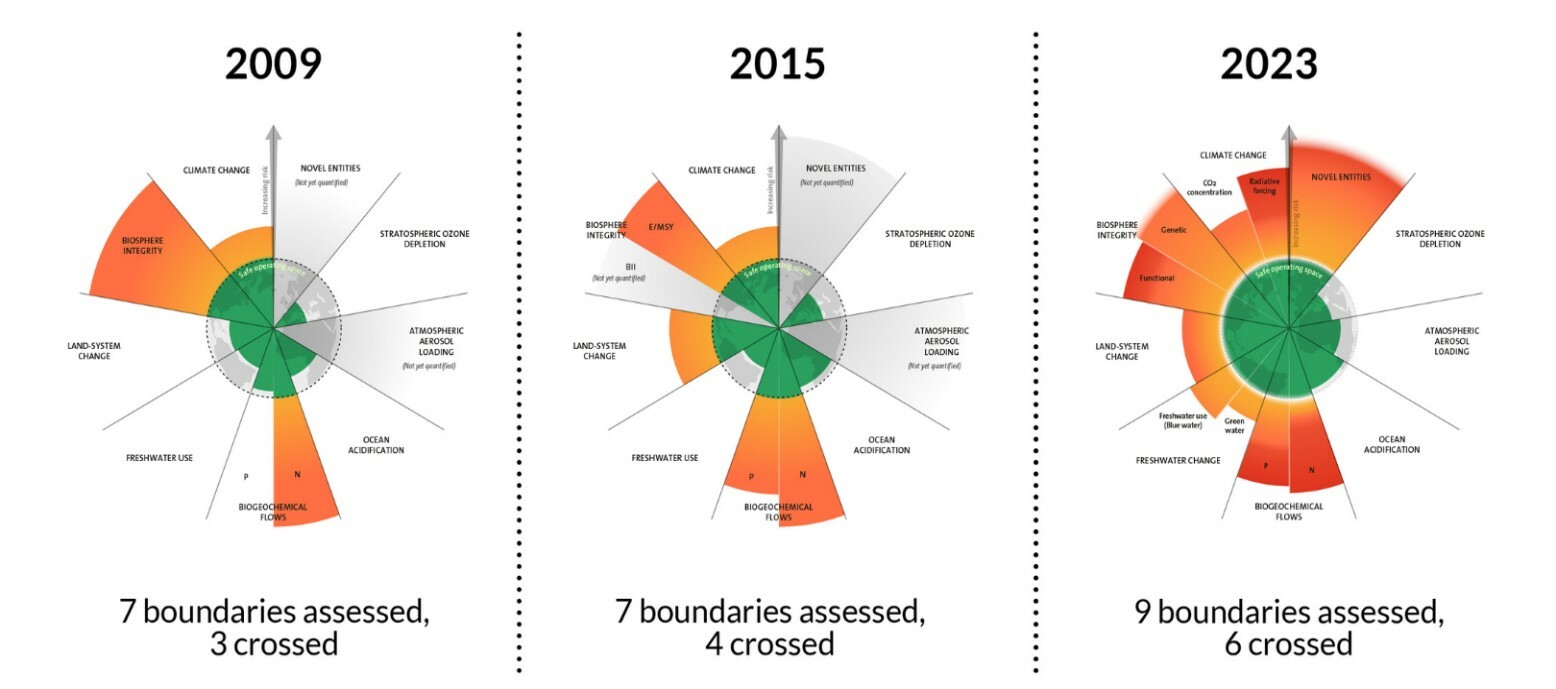
Further, the growth of inequality and social turmoil are concomitant social developments also integral to this negative pathway that Neoclassical economics (NCE) and Neoliberal ideology have set us upon. For all these reasons Herman Daly has been an important early voice critical of NCE and to its dangerous blindness which it encourages us to embrace.
A SSE sketches a radically different economic trajectory for our society and outlines a policy framework to restructure our relationship to the biosphere.
Lastly, as regards the Green New deal (as promoted in the USA) , it largely overlooks many aspects of the perilous position we now face. It ignores the problem of unrestrained population growth. It takes care not to say too much against unrestrained population growth, presumably since the USA historically is a nation of migrants.
It even suggests the ‘green new deal’ will assist the economy to continue to grow! Hence, the Green New Deal is deeply flawed. It veils its greatest flaw, a “business as usual” approach, within its apparent claims of major reforms. It is tainted, since it continues to promote a “business as usual”, while not addressing sufficiently the challenge of unrestrained population growth and other other dystopian threats like environmental degradation and pollution of air sea and rivers.
Q3: I had always predicted that with limits to growth and as societies collapse, the billionaire oligarchs would transition us from neoliberalism to direct fascism, and we are seeing this play out rapidly in the USA. We are also living in a post-truth era, with so many people turning to the ‘mirror world’ as succinctly depicted in Naomi Klein’s ‘Doppelganer’, which replaces real issues with conspiracy theories. What is your take on the current cultural zeitgeist?
I do not subscribe to a view which sees humanity as largely locked into a passive role as “consumer”, rather than a citizen capable of participating in debates and able to adopt moral positions on important social issues. Of course, we need a healthy society to foster the kind of milieu to sustain such states of affairs. While Daly, does not discuss his political views directly, his analysis assumes countries can have democratically identified policies and may have traditions that aim for the “common good”. Clearly some powerful interest groups often seek to influence public discourse for their narrow ends. This is not a new phenomena. But, I do not believe the pervasive effects of some social media, on some sections of our society, means we have been pushed into a “post truth era”. Were this literally the case; then it appears there is little chance of remedy and all may be lost. But, ideas and social attitudes are not static (nor is this desirable). The complex elements that make up our human created social world (culture and social mores) can change and turmoil is not new. The dangers of some social media influencers are real, but ideally, as society evolves and responds to malevolent sources of dis-information from some social media sources, we hope and expect that, in such a contested space of ideas and social movements, that our public discourse can reflect the better aspects of human nature. This will be up to us.
Daly in his book “For the Common Good” sketches two views of the economy, as originally identified by Aristotle. These are ‘Oikonomia’ (from which we get ‘economy’ and ‘economics’) and “Chrematistics”. Daly defines Chematistics as branch of political economy which sees value in the manipulation of property and wealth for short term gain. Whereas, Oikonomia is the management of the household “so as to increase its use value for all members of that household over the long term”.
These notions identify different approaches to the manner in which an economy can be structured and/or restructured. (See Chap 7 page 138, “For the Common Good, redirecting the economy toward community the environment and a sustainable future”).
Daly is a macroeconomist. He sets out to describe how the economy can be better structured and he appreciates how humanity can aim for ‘Oikonomia’ rather than a Chematistic economy that is essentially divided against itself.
Daly’s decries the short-term selfish grab for more and more outlined in Chrematistics (which he describes as akin to Wall St traders) where the greater good of the community is disregarded.
Hence, Daly’s political orientation is not hidden. But he embraces a view that envisages we can reorientate the aims and purposes of the economy. In more recent times, others have advocated moving to a “well being economy”. I suggest Daly was ‘out there’ raising this kind of possibility, on how to re-focus and restructure our economy in 1994.
“Personally” I don’t think we will slide fully into fascism. That is, I do not see this as inevitable, despite worrying trends in some nation/societies. I note there are resilient institutions and communities who (I believe) would oppose such a transformation. There are frameworks of ideas, social mores and embedded ‘ways of being’ . These are bound up within many communities and contain expectations about equality before the law, and notions of justice and caring for both the human and non-human world. The real question would seem to be ‘is the broader populace so disgruntled and alienated that fascism becomes some kind of answer to their plight’
I observe the Australian, Canadian and European responses to Trump’s antics and his continual stoking of division, by which he aims to white-ant and undermine more liberal (small “l”) traditions, has caused a backlash. In this regard I suggest these nations have expectations and beliefs (ways of thinking and acting) about the rule of law and other traditions that support a respect for others and our shared biosphere. These nations have not abandoned hope in the possibilities of on-going reform of our economy and society. Currently also this is not a forlorn hope within the Australian public’s psyche.
Q4: Give us an overview of the objectives and policies of CASSE. I do wonder, as an adjunct to this question, your views of whether the political and social directions that CASSE proposes could be used as a viable alternative to everyday people to rally behind, which would actually address the root causes impact their quality of their lives, without having to go down the rabbit hole of the mirror world or extreme right fascism, often out of desperation.
To preface remarks on CASSE NSW objectives and policies, I quote J.S Mill (a classical economist) who influenced Daly. Mill saw said to achieve such a large scale transition to a SSE would need:
"to be initiated by a cultural, spiritual, and political value shift towards simplicity, sufficiency, sharing, community, and a deep respect for the natural world"
For such a transition ‘root and branch changes’ are required. Daly’s ideas in summary are (I use James Magnus-Johnston, an ecological economist, remarks”):
A Steady State Economy is a dynamic market economy that efficiently allocates goods and services but uses the lowest feasible rates of natural capital depletion to achieve a high quality of life. A SSE features:
• A sustainable population size for the carrying capacity of its region,
• A distribution of wealth which is fair and equitable on an intergenerational basis _
• _Low resource use (_both renewable and non-renewable resource_s)
_ The term may apply to a city, region, nation, or to a global economy that fits within the carrying capacity of the planet’s biosphere. It was Herman Daly & Joshua Farley (2004) who summarized the three objectives of an SSE as:
- Optimal scale
- fair distribution and,
- efficient allocation, in that order
There may be some difficulty to put what “this vision” means into catchy three word slogans or into a succinct set of doctrines. Herman Daly is NOT outlining a political platform. He is providing a blue print for the kind of changes that will set up the conditions for a SSE to be workable. They are radical changes that he suggests are needed to transition to a sustainable economy that can function within natures bounds. He advocated fair distribution of income and intergenerational equity as a guiding goals.
The kind of society, its belief systems about maintaining greater equality (in supporting fair and equitable distribution) will also need our political will and our moral courage to establish it. Herman Daly essay in ‘the Limits to growth report’ of 1972 noted: “The stationary state ( he later called it a SSE ) would make fewer demands on our environmental resources, but much greater demands on our moral resources” (Victor, Peter A.. Herman Daly’s Economics for a Full World: His Life and Ideas (p. 176). Taylor and Francis. Kindle Edition.)
Daly’s three basic elements for change map important steps to begin to establish a transition to a SSE. These are part of a coherent vision that sets out the parameters needed to begin to forge such a transition.
The study of political economy shows us just how economics is an essential element in our debates on how we see ourselves and how we can (and or should) organise ourselves to attain our valued goals. It should be noted that economics is a descriptive theory about what we do and how we go about it, but it does not set out to give us our convictions on why we do it. These matters, debates and moral considerations are up to us!
But to assist peoples understanding of what is needed, we have 10 detailed policy points (from Daly’s 2015 Blue Planet Lecture) which have been recently revised and updated by Phil Lawn, a leading Australian ecological economist. These will soon be put on our Website at : https://www.casse-nsw.org.au/ . So these policy points may help to focus political interest on the need for radical change towards embracing a SSE.
I guess one could use this quote to generate interest in a SSE. Daly said:
“The economy should not be viewed as an idiot machine dedicated to maximizing waste. Its ultimate purpose is the maintenance and enjoyment of life for a long time (not forever) at a sufficient level of wealth for a good (not luxurious) life.”
Q5: In a recent article by The New Statesman, Denmark has shown it can defeat the populist right by virtue of Mette Frederiksen’s Social Democrats tackling the immigration debate in a constructive and mature way. Tell us how CASSE incorporates population into its policies why Degrowth can’t ignore population, and why the Left need to rethink how to tackle the immigration debate.
It may seem trite to mention the first of Daly’s fundamental tenets required as a blue print ( parameters to change the existing paradigm) to transition our society and its economy toward a SSE, is a radical proposal :
- A sustainable population size for the carrying capacity of its region.
Not a simple question to establish - “carrying capacity”
I have heard ecologists say the ‘carrying capacity’ of population in Australia is somewhere around 4 million. A former Public servant, Mr Ken Henry recalled his discussion with PM Bob Hawk. Hawke asked Henry “what he thought the ideal population of Australia should be?”. Henry replied “15 million”, but Hawke commented, “that’s what I thought** 50 mill** ! ”. But Henry said “No, No! I said 15 Million!”.
Clearly there are different perspectives available on this matter. Degrowth advocates who avoid addressing this issue properly are abrogating their responsibility to face this issue squarely. We need to look carefully to establish what would be truly a sustainable population. The question must be answered by those with the requisite expertise.
CASSE NSW Inc, I believe, would support the arguments and research conducted by SPA. But I note there are a number of different figures actually provided on SPA own website:
“Specific estimates of a sustainable level of population for Australia include the Australian Academy of Science, which in 1995 advocated stabilising the population at around 23 million.[4] A more recent study of Australia’s carrying capacity by Dr Murray Lane at Queensland University of Technology estimated that it ranges between 9 million and 40 million people, depending on what time scale was assumed. If long term sustainability were the aim, then the study found carrying capacity would need to be towards the lower end (9 million).[5]"
I believe CASSE NSW Inc would gravitate towards “long term carrying capacity”. So, the “ultimate carrying capacity” is a matter for constant and careful research and is likely to be subject to review in the light of new and emerging considerations.
Given the other aims of a SSE, to move toward sufficiency and reduce “over productions” and “over consumption”, while creating jobs in sustainable industries and agriculture, I suspect the lower range of population for Australia (i.e. 9 mill ) would be the more realistic figure for a SSE to target as a policy goal. But this is my personal comment on this matter. It is not a formal position of CASSE NSW Inc. A change to a smaller population would need be achieved incrementally and justly and not overnight by Draconian measures.
Q6: Sustainable Population Australia, who support PGAP, interviewed the secretary/treasurer Phil Jones from CASSE NSW Inc. in the November 2024 edition of the SPA Newsletter. Phil provided a very informative insight in CASSE NSW and its recent projects and campaigns. I will provide a link in the show notes, but please provide us your own summary of CASSE NSW, your role in the organisation, and some recent highlight.
Broadly my role as a CASSE NSW Inc co-director is :
“to advance the Steady State Economy, with stabilized population and consumption, as a policy goal and a concomitant aim of greater well-being and social equity with widespread public support.
I use my role to pursue this mission by:
• educating citizens, organizations, and policy makers on the conflict between economic growth and
(1) environmental protection
(2) ecological and economic sustainability, and
(3) national security and international stability;
• promoting the steady state economy as a desirable alternative to economic growth;
• studying and advancing the means to establish a steady state economy and what this may entail.”
To this end I am engaged in organizing a range of Webinars and I have attended and presented brief papers dealing with issues relating to establishing a SSE. One was at the Anzsee conference in Melbourne in 2019, and I also have presented several papers at successive NENA conferences.
Originally, I was the Treasurer and Secretary of CASSE NSW. In late 2019 I became a Co-director as Haydn involvement decreased due to illness.
I research evaluate, (vet) and distribute articles and recomment books of interest to our members. Our constitution allows decision making and the countenance of views within our membership via email communications. Such arrangements allow policies and decisions to be canvassed and developed between our formal quarterly meetings, when needed. I publish suitable materials from various sources (some from CASSE in the USA ) relevant to issues on sustainability and the SSE, which I share and I put on our CASSE NSW Inc website.
Current project - Submission to the Federal Productivity Commission.
We recently wrote and made a Submission to the Australian Federal Productivity Commission regarding the proper goals and strategies to be used in the adoption of a Circular Economy approach for Australian industry and agriculture. Central to our submission was the advocating the goal, of this shift to circularity in our economic processes, be an integral part of a root and branch shift to a SSE.
We continue to work on this project and I am contacting overseas academics with experience and expertise related to the challenges and strategies necessary to establish a circular economy in Europe.
Q7:What are some upcoming plans for CASSE NSW Inc or for yourself? How can people living in New South Wales get more involved with the NSW chapter?
As noted above we are continuing to promote our petition to Federal Parliament and working on helping to (hopefully) shape some to the policies to be adopted by Government as adopt strategies directed towards embracing a move to a Circular Economy.
Other information CASSE NSW Inc’s work, can obtainable through :
Contact us via Email : [email protected]
Visit our Website at : https://www.casse-nsw.org.au/
We invite interested people to join CASSE NSW Inc. We welcome interested parties and invite them to get involved and contribute their ideas and enthusiasm to help educate the public and ‘decision makers’ about the value of a transition to a Steady State Economy. Our Website contains a lot of useful material (copies of papers, books, blogs and videos), current news, related ideas and strategies relevant to help shape a constructive dialogue in support the important transition to a SSE.
]]>In my previous blog post for PMC, "Population Growth and Wealth Inequality Are More Entwined Than We Thought: Here’s Why," I discussed how rapid population growth exacerbates inequality, entrenches overconsumption, and dilutes both democracy and innovation. These areas warrant further study and discussion.
The recent decline in political and social cohesion underscores my concern that our globalized society has grown too vast and complex to adequately meet the diverse and individual needs of 8.2 billion people.
Research suggests there are cognitive limits to the number of social relationships the human brain can sustain. In Sapiens, Yuval Noah Harari argues that beyond relationships (what is referred to as Dunbar’s number), societies must rely on abstract symbols such as branding, myths, and bureaucracies to maintain cohesion. Similarly, in Collapse, Jared Diamond suggests that civilizations throughout history have ultimately crumbled under the weight of their own size and complexity, unable to adapt to disruption. Sound familiar?
While modern technology has temporarily allowed us to function within an increasingly vast and globalized system, it has done so through the rapid transmission of communication, transactions, and most notably, advertising and propaganda. This has turned most of us into participants in a ‘one size fits all’ deregulated, ever-expanding system that accelerates its own growth while consuming the living world at an ever-faster pace.
For many in the Global North, standards of living have arguably peaked, stagnated, or even declined, at least if we use GDP per capita as a measure. Yet the invisible forces driving our growth-based economy have convinced us that this system is both inevitable and natural, with deregulated, trickle-down economics framed as an unquestionable law of progress.
Unlike the kings and emperors of old, today’s ruling classes have until recently, hidden behind the illusion of democracy. Politicians, funded by billionaires, serve as their public enablers and apologists, while election cycles in most Global North nations force us to choose between two parties offering increasingly indistinguishable policies. Yet the real power remains out of reach, untouched by the ballot box. As their dominance grows more absolute, billionaires have become increasingly brazen—just ask Elon Musk.
This intricate, self-perpetuating system has, until now, been flexible enough to bind together 8 billion people. But several fault lines are beginning to crack. The cost-of-living crisis is one example driven by the natural limits to growth, a speculative economy built on inflated property prices rather than real productivity, and worsening wealth inequality. The result is a hollowing out of society, eroding the middle and working classes. History suggests that such conditions often precede the decline of once-mighty empires.
Before COVID, I believed the political left was winning the ‘culture wars’ but failing the ‘climate wars.’ On principle, I support social justice and equity and recognize that the left has sought to amplify diverse voices and perspectives. However, in practice, the movement has sometimes fostered a culture of censorship. Discussions on population sustainability, for instance, are often met with knee-jerk accusations of ‘ecofascism’ or ‘racism.’ Instead of fostering broader understanding and tolerance, this dynamic has fuelled new ‘us vs. them’ divisions, pushing many working-class conservatives, already disenfranchised by neoliberalism, further away.
Post-COVID, we have witnessed the rise of political diagonalism, a phenomenon Naomi Klein explores in Doppelgänger. She describes a strange alliance between the far right and the alternative wellness community, a ‘mirror world’ whereby conspiracy theories flourish in place of systemic analysis. These narratives are seductive precisely because they simplify complex global crises into digestible hero-villain stories. They provide an easy scapegoat, often liberals or minority groups, allowing followers to deflect both personal responsibility and an honest reckoning with cause and effect.
Now more than ever, critical thinking is essential in distinguishing truth from post-truth. Yet, as education systems erode, particularly in lower socio-economic communities, many are left vulnerable to misinformation, fed a steady diet of sensationalist, oversimplified media. In this climate, disinformation spreads like wildfire, even as the world quite literally burns.
Human societies have always existed within relative truths. Money, economics, hierarchy, even morality, are constructs of our collective subjectivity, shaped through language. Language, while a necessary tool for navigating complexity, becomes dangerous when our egos become entangled in the ephemeral world of narratives. Today, as communities corrode—due in part to austerity and in part to sheer overpopulation we find ourselves increasingly fragmented, living in close quarters yet unable to organize cohesively. As our worlds become more insular, myopic, and self-absorbed, our narratives spin further out of control.
In my experience, the biosphere and the natural world exist (generally speaking) beyond human storytelling. It is the closest thing we have to an objective reality, a physical truth unmoulded by human interpretation. For most of history, the natural world vastly outweighed the human world. Even as civilizations rose and fell, nature provided a grounding force, a check and balance against our self-created illusions. But today, that balance has been obliterated. Wild mammals now account for just 4% of global mammalian biomass. For many, access to the natural world has been reduced to curated, artificial experiences, a trip to the city zoo or a national park, often more about aesthetics and Instagram posts than genuine reconnection.
The ratio of human-made to natural environments has inverted so dramatically that we are now almost entirely subsumed by our own creations. Physically, we are enclosed by sprawling suburbs, towering apartments, and endless urban landscapes. Virtually, we are consumed by screens and social media; an echo chamber of human narratives. With little access to nature, is it any wonder we have entered a post-truth era, where so many feel unmoored and lost?
The psychological scale of this crisis is staggering. How can a globalised society truly address 8.2 billion individual narratives, each with unique needs and grievances? The only common thread seems to be that no one feels fully heard or understood, not even billionaires, who often appear more insecure and unhappy than the rest of us. The more people there are, the more each individual voice is drowned in an ocean of noise. This weight, though intangible is deeply felt. I compare it to Atlas, bearing the literal weight of the world on his shoulders.
No one can sustain this burden alone. In confusion and desperation, many seek simple solutions to complex, unfathomable problems. This is when the temptation arises to rally behind the loudest, angriest figure in the room; the one who projects unshakable confidence and offers the illusion of easy answers. History has shown us where this path leads: fascism, oligarchy, tyranny, scapegoating, and, inevitably, dystopia.
Yet complex problems require complex, multi-layered solutions. There is no single fix, only a collective effort. Our bloated, unsustainable societies must embrace planned degrowth, scaling down economies to levels that do not literally cost the Earth. We must rewild—restoring balance between the human and natural world, reviving biodiversity, and making space for life beyond ourselves. And we must finally confront the population issue with maturity and seriousness. This is not a matter for conspiracy theories or reactionary outrage, it is a fundamental issue of human rights, environmental stability, and long-term well-being. Expanding global access to family planning not only curbs overpopulation but also empowers women, strengthens communities, and fosters economic resilience. In the Global North, choosing to have fewer children has a greater impact on carbon emissions than multiple lifestyle changes combined. A stable or declining population should be seen as a success, not a crisis, regardless of what Elon Musk might claim.
Ultimately, the only way to escape this dystopian spiral is to let go of our self-absorbed narratives and re-establish our relationship with the natural world. To do means actively working to look for connection and common ground among those we disagree with as a pathway towards constructive discourse. For this reason, new activist movements such as Holistic Activism are becoming increasingly important. However, the more of us there are, the harder this becomes both physically and psychologically. Population sustainability is not just an environmental necessity; it is a human rights imperative and I believe, a psychological one as well.
]]>Hi, my name’s Michael Bayliss, and I have been blessed to call Albany home for just over 3 years.
Aside from being a musician and a volunteer for the Friends of Yakamia Boodja, I work as the Communications Manager for Sustainable Population Australia. I guess I could say I work in a niche industry. The core of what I do involves questioning our globalised, growth based economy and the often negative consequences this has on our communities and our natural world while exploring alternative ways of living. I host a podcast with my co-host Mark Allen who is here in the audience, called ‘Post-Growth Australia Podcast’, which explores many of these ideas.
The Festival of Torbay today has been filled to the brim with encouraging talks and workshops, all pointing the right way toward a sustainable future of grass roots, local community based voluntary simplicity.
We all know this is the way forward, so it is a terrible shame when festivals such as this are the exception and not the norm.
We have learnt much on the native flora and fauna of Tor Bay, and have been up skilled across many gardening and homesteading skills. Energised by all of this, we will all head home mostly to find that the majority of our communities continue to march in the opposite direction.
Mining companies will continue to knock on the doors of farmers insistent on fracking on their land. Resource hungry ring roads will be built to justify the ever expanding mining operations. The remnants of native bush, such as Albany’s Yakamia forest, will be mowed down for the sake of more poorly planned, poorly built urban sprawl, all in the name of ‘growth and jobs.’
I am definitely not saying this to be a party pooper or take away from any of the brilliant talks and workshops today. However, we must put this into context. Without system change, we find ourselves in a tiring and exhausting cycle of putting out spotfires while the scale of the problem escalates.
I was going to ask a rhetorical question to you all around whether anyone thinks it is possible to have infinite economic growth on a finite planet, however I believe we all know this this is physically impossible. It is David Attenborough who said that anyone who believes in infinite growth is “either a madman or an economist.”
Australia’s GDP has been increasing by 2% every year, which means a doubling of our entire economy every 35 years. In the land of exponential growth things escalate quickly to the point where the size and scale is untenable, despite what our politicians and experts might try and convince us otherwise.
I recently found another excellent quote online: “You have to ask yourself: if our economic system actively destroys the biosphere and fails to meet most people’s basic needs, then what is actually the point”. This quote is from Jason Hickel who is an anthropologist at the Autonomous University of Barcelona and author of “Less is More.”
Katherine Trebeck, Senior Strategic Advisor for the Wellbeing Economy Alliance, says (with slight paraphrase) “Our Western societies needs to come to terms with the fact that we have ‘arrived’. We don’t actually need to keep growing.” She is co-author of the book ‘The Economics of Arrival.’
It has been nearly 55 years since the book ‘The limits to growth’ was released in 1972. In it, they used computer modelling to explore the consequences of pursuing exponential economic and population growth, resulting in a collapse of society by mid 21st century. So far our trajectory has eerily followed the models of the ‘business as usual’ scenario outlined in this study.
This decade, to what we call ‘the decade of consequence’ in the podcast, the environmental consequences are definitely tangible. Globally, we have breached almost all planetary boundaries. In the age of anthropocene, the numbers of non-human or non-livestock animals are in freefall (the number of humans, not so much). Subsequent Federal State of the Environment reports detail our natural world in severe decline. Human interference is always cited as the main culprit, with urban expansion and population growth now the predominate drivers of local environmental decline. The last federal State of the Environment Report was almost not released, perhaps by the shame of hard truths held in those pages. I don’t believe that WA has released a ‘state of the environment report’ since 2007, which is telling.
If we can agree that infinite growth on a finite planet, a finite continent, a finite south-west, are not inherently great ideas, what are the alternatives? Thankfully, many viable alternatives have been proposed. These include the Steady State Economy from the late Herman Daly, the Doughnut Economy championed by the great Kate Raworth, or planned Degrowth as championed by the Post-Growth Institute.
The Post-Growth Australia Podcast has explored many of these ideas. We have interviewed Ted Trainer, who advocates for voluntary simplicity. We have interviewed Charles Massy and David Holmgren, two very well known Australian advocates of permaculture and regenerative farming. We have interviewed John Seed, where we explore the idea that our broken economic systems stem from a deeper problem arising from our collective disconnection from the natural world. Only by relearning to place ourselves as part of the natural world, rather than trying to dominate it, can we live in sustainably and in harmony.
PGAP also focuses on grass roots game changers here in WA. We have interviewed Murray Gomm from Oranje Tractor winery. We have interviewed spokes people from The Friends of Yakamia and Save Perth Hills who are active in stemming the tide of the latest land release or overdevelopment project. We have interviewed Larry Blight, Menag cultural educator. Last but not least, we have interviewed Professor Anne Poelina, a Nyikina Warrwa woman from the Kimberley region and chair of the Martuwarra Fiztory River Council, and lead author of the book “Declaration of Peace for Indigenous Australians and Nature”.
So, many great minds and ideas out there, but what can we do as Davids against the Goliaths of psychopathic multinational corporations and the politicians who serve time as their apologists for a few years in the promise of a cushy job in the gas industry? This is where I invite you to think about where from here and let’s have the conversation. Firstly, if the concept of ‘degrowth is new to you I strongly encourage you to do your own research and investigation, I am happy to give you some pointers. Secondly, it would be great to see some of us come together, to create united front advocating for post-growth in the great southern. While we continue to engage in our respective causes, we must work toward some common cause of systemic change so that we’re not constantly battling spotfires while losing sight of what the underlying symptoms are – that there are 8 billion of us as part players in an exploitative economic system. This is where Holistic Activism, a movement founded by Mark, can help join the dots. He can tell you more after the talk. If population growth in the South West is a concern of yours, I’m happy to tell you more about Sustainable Population Australia and their efforts to encourage a hygenic, non-divisive perspective to the debate.
At the very least, it is important that there is some united blow back from the community every time our leaders excuse ever more degradation of our beautiful communities in the name of progress, development and growth.
Thank you.
]]>Of course, the fact that being a homeowner is now a pipedream for so many people is wrong on so many levels. This is because Australia has become a neo-liberal society on steroids that relies heavily upon real estate and housing speculation. You can read about why the housing crisis is here to stay but how, with major systemic change (something that we need to tackle the climate and ecological emergency) we can start to claw back control from the investors, developers, and speculators here.
So due to having family support, and after years of having lived in often substandard accommodation, I was lucky (unlike many others) to finally obtain the housing security that I so desperately needed.
Finding a place to live
Like an increasing number of Australians, I migrated from one of the large state capitals (Melbourne) to a regional town (Albany) which in part would enable me to escape the rapidly worsening rental market and find somewhere that is affordable to purchase. Finding a suitable place to live in Albany was the next task.
Unfortunately, there was very little on the market in 2022 that was within my price range that wasn’t a fibro asbestos house in need of a lot of renovation. Because I was renting a crumbling asbestos house at the time, I was keen to not have to face the stuff again in a hurry (Mark had also just spent over four grand getting an asbestos shed and porch removed on a unit that he was renovating).
It was also at a time when large parts of Eastern Australia were locked-down due to the Covid pandemic. While WA’s border was closed, there was talk of house and land prices increasing sharply as soon as the border reopened. That combined with building supply issues and a lack of tradies meant it was an edgy time. So, I decided that it was important to purchase a piece of land as soon as possible and look towards getting a small house built at the earliest opportunity. With hindsight, this was just as well because the cost of housing and construction has increased massively in the last two years. The downside however, is that due to feeling rushed, I didn’t have the time or opportunity to do enough consultation and preparation in order to get the best overall outcome. Also, this meant that I left a lot of the decision making to the building company, which with hindsight, I would not have done. But more on that later.
I managed to find a weed infested infill block that is about 700 metres square in size, located between two existing houses that appear to have been built in the early 1990s. Building here would finish the street off and the idea was that by building a smaller house, I would have plenty of room to plant a native/permaculture garden with substantial trees along the fence line.
Figure 1: The vacant block
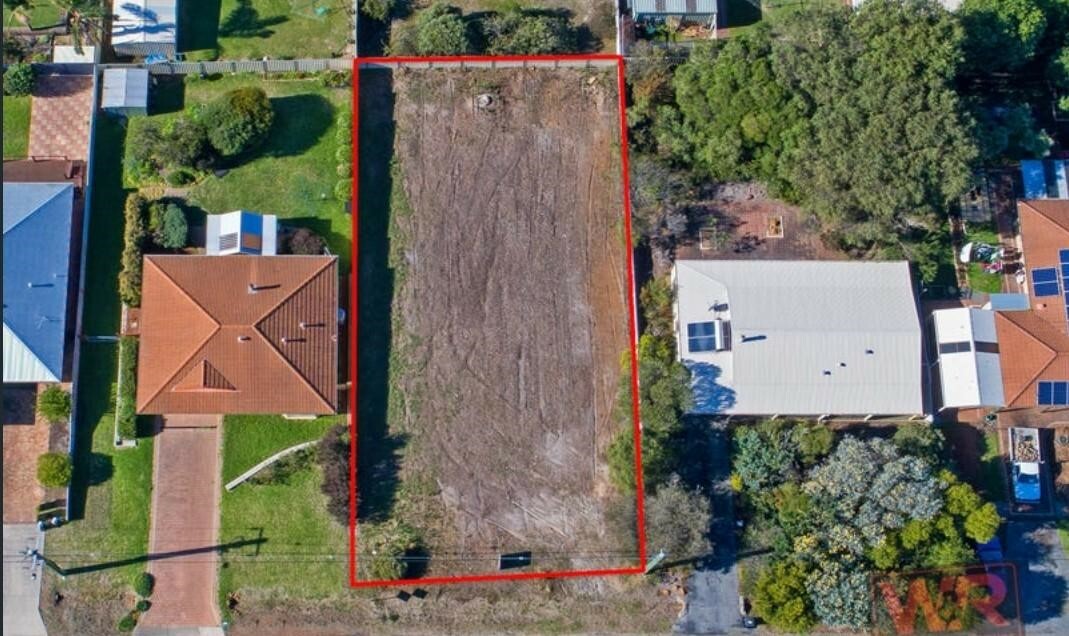
Sadly, the budget did not allow for a bespoke house to be built from scratch and time was also of the essence. The land had already set me back $155,000, so the decision was made to build a project home with an established large building company and adapt it as much as possible to make it smaller and greener.
I ended up choosing Country Builders because rightly or wrongly, I felt that they would deliver a better-quality product. This was in part because they provide a ten-year guarantee on new homes. They also appeared to get their houses built quickly, at a time when the length of time to build new houses seemed to be increasing. Crucially Country Builders also appeared to be too big and too well-established to go under in an era when many building companies are going broke.
Choosing the design
Before approaching Country Builders, I spent some time researching passive house design and discussing options with local permaculture enthusiasts. This included a ‘tour’ of my block from students who were undertaking a course at the local TAFE. This, combined with some inspiration that I took from small and tiny houses that I had seen during my time in Victoria, helped to inform my initial draft of the house design.
So, I met with Country Builders to explore my ideas, and agreed that ‘The Brisbane’ was the most appropriate choice from their catalogue of options. But it would nevertheless require several significant modifications. The first modification was to make it into a single garage house. The second was to rearrange the floor plan significantly so that the living area would now face North and the sleeping areas would face south. It was important to me to have a north facing, open plan design which maximised interactivity with the outdoor space, so I also removed the theatre room from the original plan and compensated it with a larger veranda at the back. It now meant that it was wide enough to span the width of the house.
At this stage Mark joined-in with the design process.
It was then decided to widen the living area slightly to compensate for the removal of the theatre room. We also decided upon a weatherboard indoor feature wall as a nod to a more traditional WA aesthetic, especially as there is also some weatherboard on the façade.
After some discussion the decision was made to construct the house from a more traditional brick rather than the square concrete blocks that are currently popular but do not appear to age well.
These cosmetic changes added to the budget, but we felt that they were necessary in order to give the house some individuality, character and connection to the streetscape. It was also decided to pay extra to have paving laid all around the house and to increase the width of the driveway in order to accommodate two cars side-by-side, especially as we had downsized the garage from a double to a single.
Figure 2: The decision to choose a more traditional brick added to the cost of the build (left)
Adding bamboo floors and an internal weatherboard wall also added quite a lot more to the cost of the build (right) but it made the house feel more homely than the plasterboard and vinyl floor alternative.
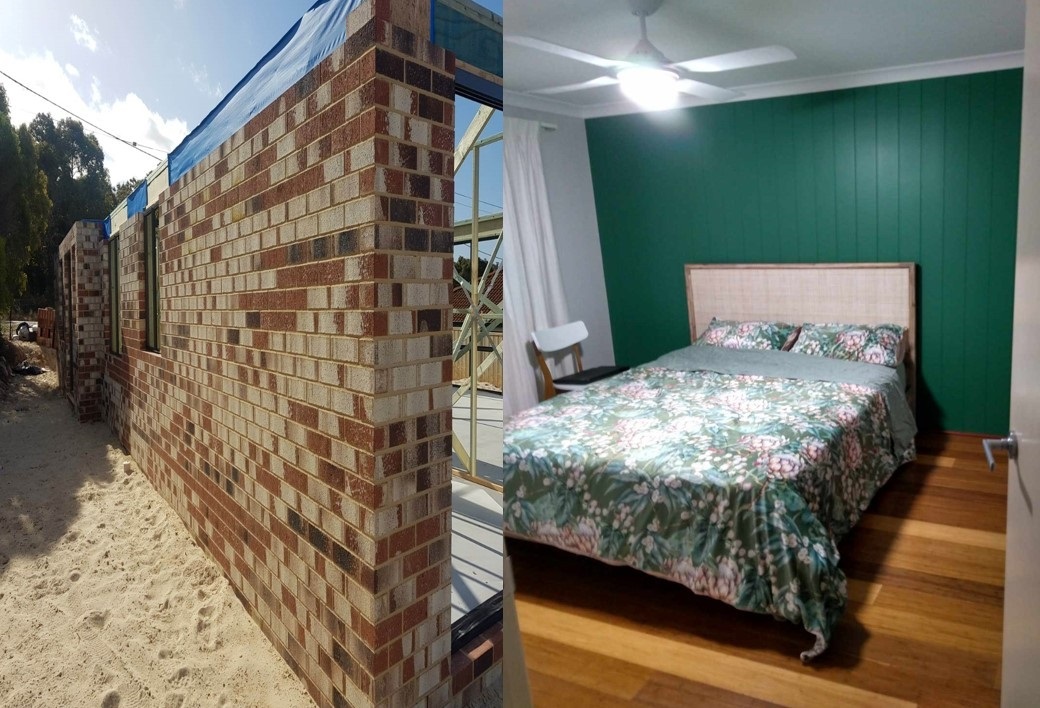
Greening the build
I soon realised that Country Builders was not particularly sympathetic to me wanting to make the design and build as green as possible and I was told upfront that: “if you want to be green, don’t build a house.”
Obviously, the greenest thing that anyone can do is to not build a house at all; that is unless it is built out of recycled tyres and carbon absorbing hempcrete, but sadly this was not an option for me in Albany at this time. Due to Australia’s massive housing crisis and rapid population growth, the reality is that a large number of houses will need to be constructed quickly as a consequence of decisions made by the Federal Government. And the majority of this housing construction will be undertaken by project builders.
So, the main onus has to be on building companies like Country Builders who construct project homes. Therefore, it is important that they be open to adapting their designs and their approach to the construction process in order to create increasingly more sustainable buildings. Bearing in mind that construction is responsible for between twenty and forty percent of all emissions, and the fact that the climate catastrophe is accelerating, everyone working in construction has a massive obligation to make it greener.
So, we had to decide where to invest the limited budget that we had left over in order to make the build greener. Because apart from making the house smaller, all green additions would come at greater expense.
A huge component of building more sustainably is ensuring that you have the best quality fixtures and fittings within your budget so that you do not have to rip stuff out and replace it down the track. One thing that we learned is not to rely upon the building company to choose the best products, so you will need to scrutinise all the proposed fixtures and fittings. For example, we requested a cistern sink toilet, in part to save water (also because they still build houses in WA without putting wash basins in toilets - which is strange) and this felt like a clever way of getting round that. We should however have chosen the model of toilet ourselves because the one that was eventually installed is impractical and difficult to use. It is a pity because there are some good models out there, so it was a missed opportunity.
Country Builders were also more than happy to install a heat pump hot water system (we still have a long way to go before heat pump hot water systems are the default option). However, it was installed directly outside the second bedroom. While the noise from heat pumps is usually not an issue, it can be an issue when it is located directly outside a bedroom window.
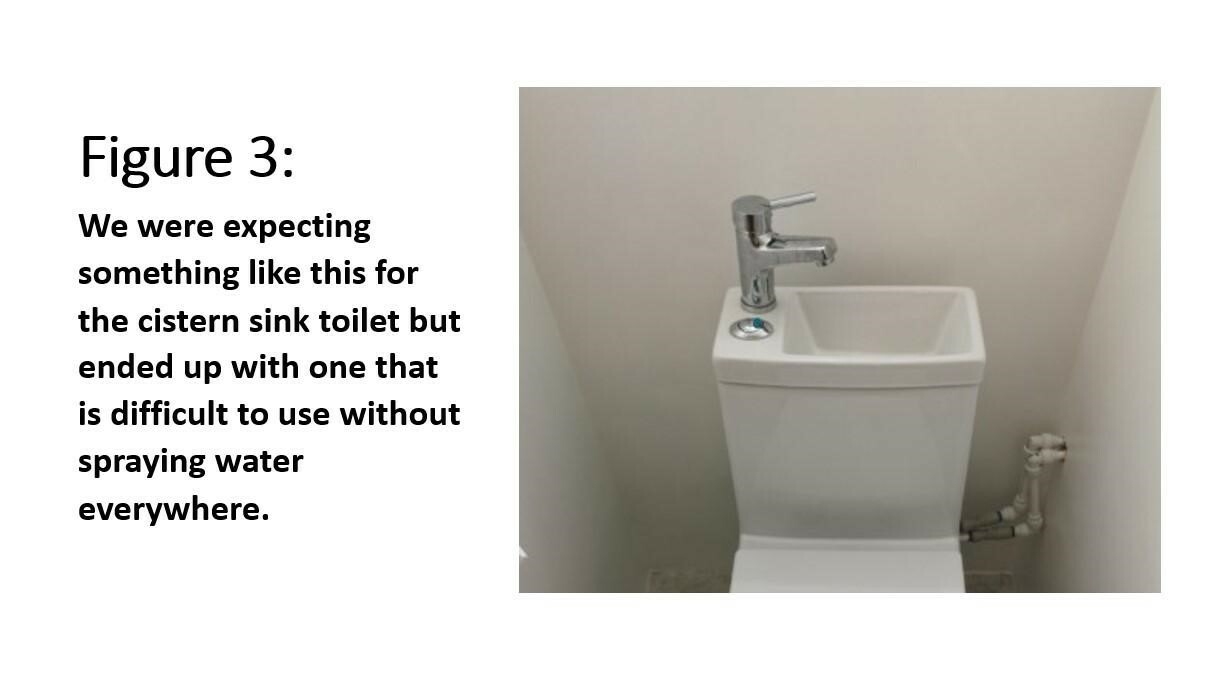
The rational decision would have been to locate it next to the kitchen at the other side of the house. However, this would have meant changing the design to make it fit. With hindsight, more effort should have been made on our part to ensure that we chose a better-quality quieter model.
As a result of this oversight, it is generally necessary to have the window shut when sleeping in the second bedroom, which is unfortunate. So, it is important to think about the location of the heat pump and to direct the building company accordingly. You cannot expect the building company to sit down with you and say ‘look, we are going to place the heat pump directly outside the bedroom window, so you might want to pay a bit extra in order to get one that makes virtually no noise’. It just won’t happen. Despite this we are optimistic that we can reprogram the heat pump to only hum during the day. Right now, it is probably programmed to do its work when electricity is off-peak but the rooftop solar system that we plan to install down the track will hopefully mean that it will do its charging during daylight hours.
With hindsight we would also have asked that the heat pump be located on a slab so that it is elevated above ground level in order to give it a chance of having the longest possible lifespan, especially as heat pumps, like all green technology, have a lot of upfront carbon emissions embedded within them.
Regarding longevity, the water in Albany is very hard so we were advised to install a water softener in order to lengthen the lifespan of the heat pump and other water related fixtures, which is what we did. This resulted in the tap water being a little salty, but we also took the opportunity to install a reverse osmosis water filter under the sink for drinking water, so it is not an issue. The other reason for installing the filter is because Albany water is pretty bad for a number of reasons.
As well as the cistern flush and heat pump system, we decided to install a 1,500-litre rainwater tank, which can also be connected to the laundry. With hindsight, we would have had a second water tank installed on the other side of the house in order to provide more water security at a time when the climate is changing, and Albany is literally running out of water.
Another major greener addition that we decided upon was to have bamboo floors as opposed to the vinyl option that Country Builders was putting pressure on us to have. This is a decision that we do not regret but they do scratch easily, so all furniture needs to be padded underneath and it needs to be a shoes-off house, which is fine by us. But it is worth it.
There were also a number of additions that we had to ask for as we thought that they are a given, such as ceiling fans. Of course, adding ceiling fans massively reduces our reliance upon air conditioning. Asking for this kind of thing is something that can be overlooked when you have a lot of upfront decisions to make very quickly when starting a new build.
One thing that we did overlook was the absence of a screen door in front of the front door on the plan. We assumed that it would have one as all the other doors and windows had screens. This means that if we want to cool the house down in the evening with a through draft by opening the front door and the back door, we have to accept that there is a clear path for the mosquitos to get in. Again, do not expect the building company to sit down with you and suggest ceiling fans and front screen doors, even though their addition could do a lot to save on energy consumption over the lifetime of the house.
We were also surprised that we had to ask for the home to be all-electric, even though the street is not connected to the gas mains. The default option for Country Builders is to install bottled gas. While we would like to see all new homes be made all-electric, as is now the case in Victoria, there should at the very least be some discussion with the client regarding the option to go all-electric rather than the default option always being gas and electric.
We also had to intervene to prevent the installation of manufactured stone benchtops in the kitchen. This was more than a year before the ban, but the health impact of installing these benchtops was very known to the industry at the time. There was quite a bit of pressure on us to install them, possibly because they had stockpiles of the stuff. By choosing vinyl laminate instead, we saved money and with proper care, they will easily be as durable as the rest of the laminate chipboard kitchen.
Modifications we should have made and the perils of building on a sloping block.
Because we were thinking about making a lot of modifications in a short period of time, we put less attention into the layout of the kitchen itself, particularly regarding storage space. Had there been more time, we would have scrutinised the kitchen layout much more in order to get a better outcome. We were surprised just how little cupboard space and work surface there was in the finished kitchen. When you consider the space needed for a chopping board, kettle and toaster as well as an area to stack dishes, there is very little room left over for food preparation. So too for storage. With hindsight we would have widened the kitchen to allow for extra cupboard space and another metre of workbench. This might not sound like much, but it would have made a huge difference.
As mentioned before, it was important for us to build a smaller house. Australia has some of the largest houses in the world. However, for the sake of adding an extra half metre in the right places, you can achieve a lot more grace while still having a small house. With hindsight we would not only have widened the kitchen by half a metre, but also the second bedroom, making it much more comfortable to sleep two people.
Also with hindsight we would have, if possible, added an extra half metre to the ensuite shower room. This would have made it much less claustrophobic, so that you could get out of the shower and dry yourself without smashing your elbows against the door. It would also allow space for a chair to place your clothes while showering. Making the ensuite larger would have resulted in lengthening the house by half a metre, which would also have given us a slightly larger living area (this would have been good, especially, as the theatre room had been removed from the design).
But while widening the house slightly in two places would have been easy, lengthening it would have been more problematic in this case, because it is a sloping block. The distance between the ground floor of the house and the ground outside is already at two metres at the bottom left corner.
Building a project home on a sloping block adds a new level of complication, especially when there is little communication regarding how best to go about this. We had suggested that the back half of the house be split level or constructed on stilts but that was quickly dismissed by Country Builders. We are not sure whether this is simply because it is impractical, or whether it is something that they simply do not do, but at the very least there should have been some discussion about the implications of building on a sand-pad on a sloping block. For example, being given the option to construct retaining walls upfront before the build so that the sand-pad could be compacted up to those walls. This would have saved a lot of wasted sand that had to be dug out and trucked off-site as part of a much more complex and difficult landscaping project that required retaining walls to be constructed after the fact.
Had we built retaining walls upfront, we would have had the option to have a much shorter sand pad (and therefore a shorter retaining wall at the back) as the veranda could easily have been built on stilts, encapsulating the back retaining wall beneath it. This would have allowed for a larger back garden or at least the option to lengthen the house slightly as discussed earlier.
This would of course all have come at considerably more cost, but it turned out to cost an additional thirty thousand to properly landscape along the edge of the entire sand-pad after the build was completed. We were very lucky that there was a landscaper who was available to do this almost as soon as the build was completed as many people are having to wait for a year. We went for a mixture of rocks and gabions and he did a great job under unenviable circumstances.
So much more discussion and openness to new ideas and options would have been great but sadly, Country Builders tended to adopt more of a ‘naysayer’ approach. Being new to the game meant a lack of self-assuredness on our part, which combined with the desperation to get the house built quickly, meant that with hindsight, we should have been more assertive with them. We need assertive clients to push construction companies to become much more sustainable. If you are assertive with Country Builders and know what to ask about and look for, they should generally be accommodating and they will deliver a good result.
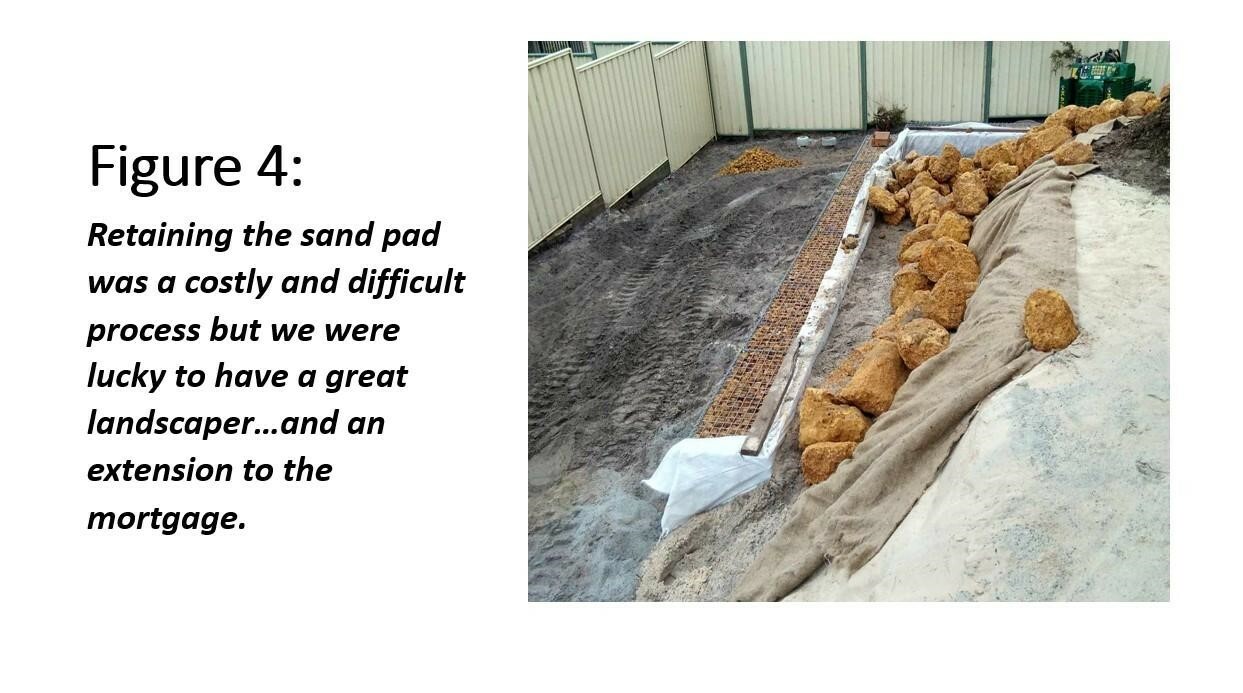
While our attempts at having a part sand-pad half stilt house did not happen, we did get some success by working with Country Builders to get the positional layout of the house correct. This has resulted (to date) in an outcome where the house has so far 'got away’ without having double glazing etc.
Some substantial reworking of the plans occurred here including locating the house more towards the south side of the block to allow winter sun to enter from the north. We also relocated the bedrooms to the south side with the living and kitchen areas being repositioned to be north facing. A trellis was also installed on the north perimeter of the house where passionfruit vines will be planted to make most use of the sun and to provide some shade during summer. The front office room, which faces east, gets blasted by the afternoon summer sun. A mulberry tree in front of the window will hopefully alleviate this issue, once the front garden is established. It would however, with hindsight, be nice to have had a small veranda at the front of the house to compensate for the lack of eaves in that position.
Figure 5: A front looking more like this might have helped.
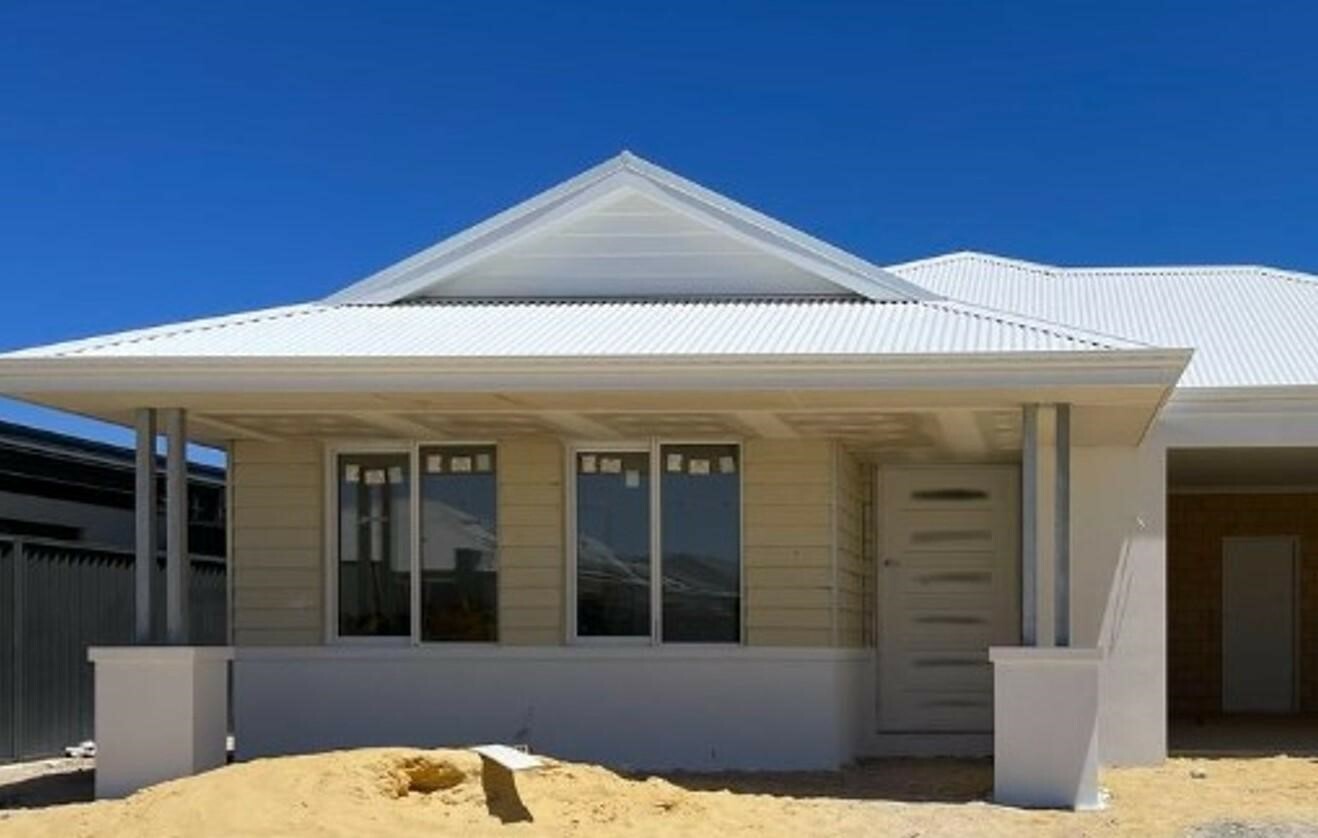
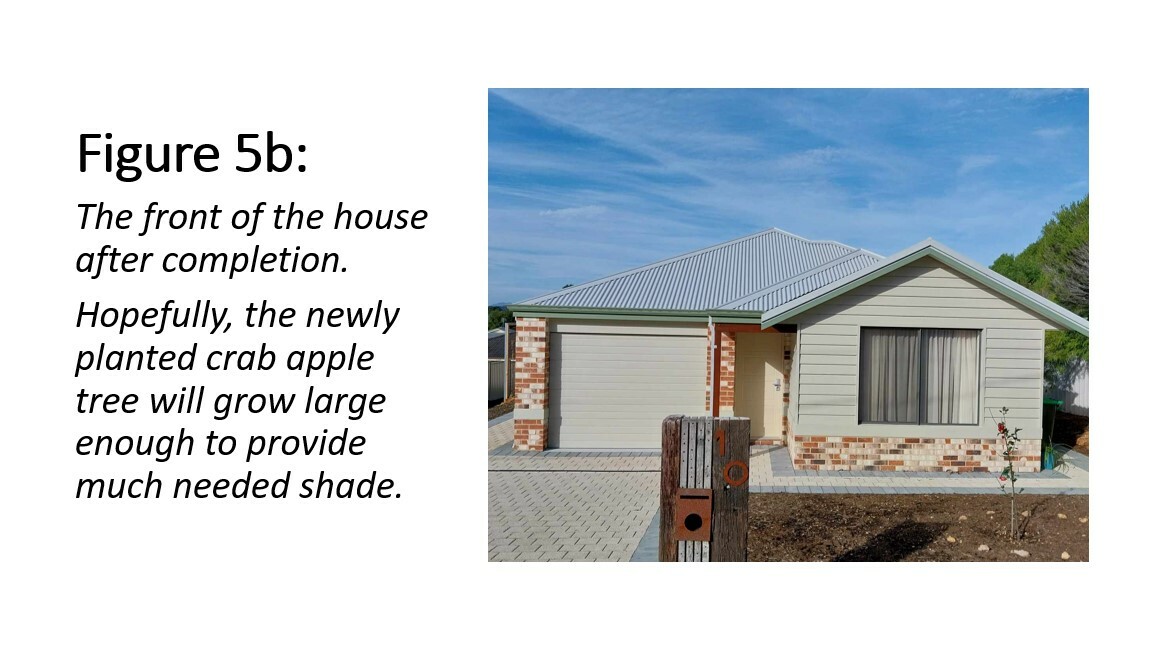
Conclusion
Building with a company such as Country Builders can be a positive experience, if you know up-front that it is ok to be constructively assertive with them. While this blog may sound like a list of First World problems and it really is, we must take every opportunity to improve the way that we build, because if we must do it, we may as well do the best possible job that we can. Especially as we have created a society where much more home building is going to be required on an ongoing basis, at least until we hit the next stage of limits-to-growth. Crucially whenever construction does happen, we need to work to ensure that the construction process and outcome is much more sustainable.
Small changes such as reducing construction waste (and there was a lot on this build, but we did rescue quite a bit from the builder’s skip) installing ceiling fans and well installed heat pumps in the right location are as important as anything else.
If anyone reading this is interested in building a similar designed house, especially in WA, especially with Country Builders, please contact us, as we would be happy to share plans and show you round what we have built. The greatest legacy of this project would be for someone to actually build an improved version.
Figure 6: The design we went with and the adapted design that we would go with today if we had our time again.
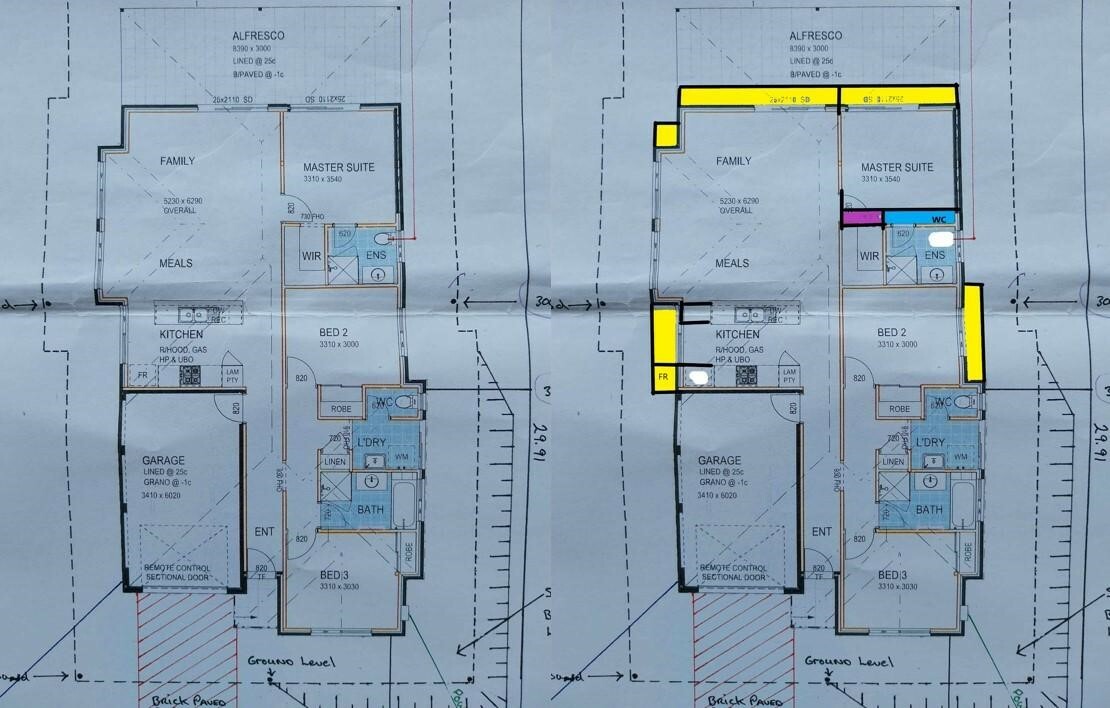
The areas shaded in yellow are the places where we would widen and lengthen the house. The areas shaded in purple and blue highlight a widened walk-in wardrobe and ensuite made possible by lengthening the house.
Figure 7: The house after landscaping taken from the rear.
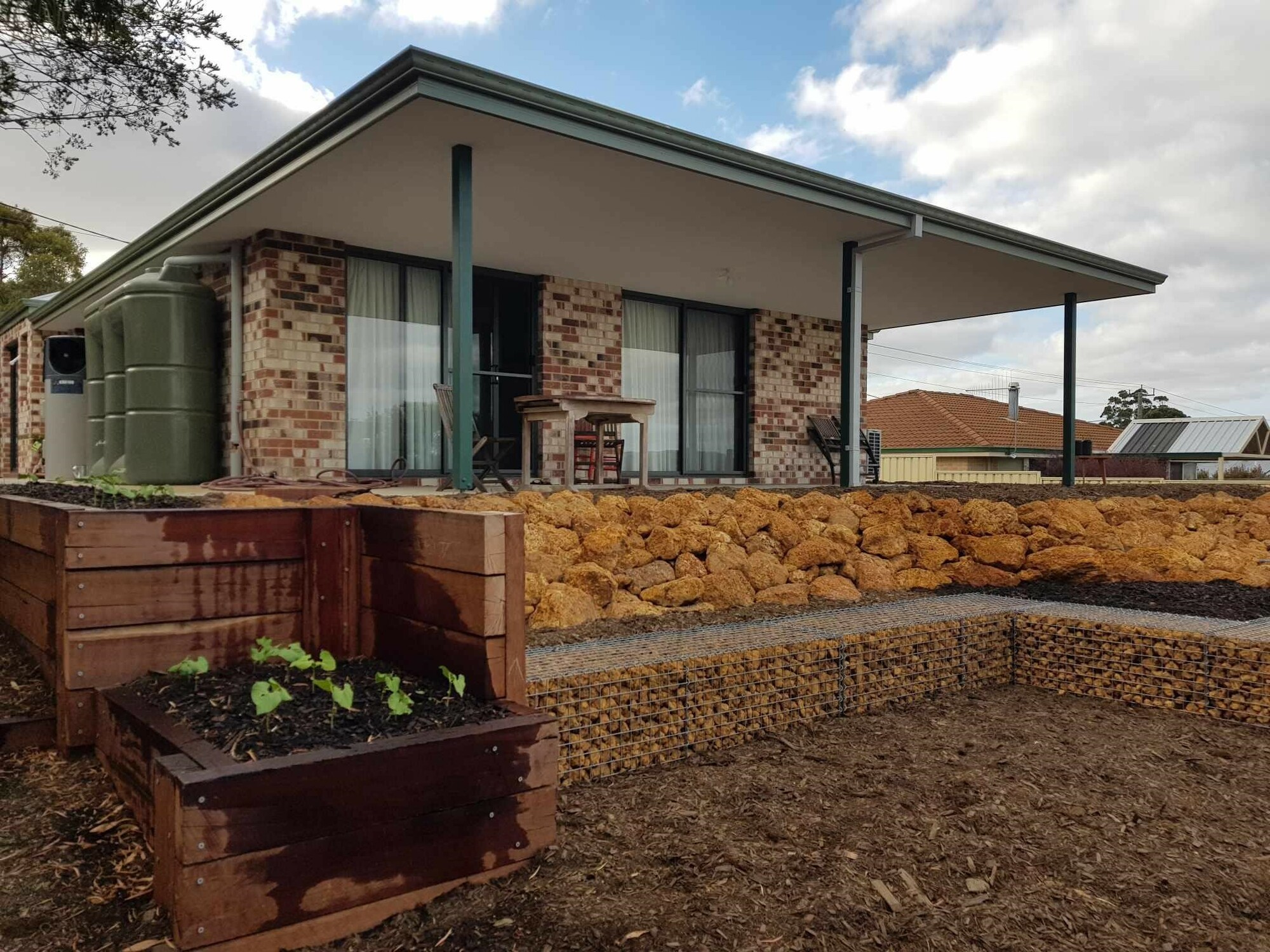
This podcast has always been about the broader issue of post-growth, which includes constructive discussions with our guests, who may often hold different or contrasting perspectives on population. Sometimes this necessitates some additional commentary from us in the outros in order to provide further qualification, clarification and nuance. However, we are also mindful that this may get repetitive, and it would be handy if there was one ‘go to’ place that people could go to for further reading. This, friends, is the place. Read on!
The issue of population is one of the most divisive issues in the environmental movement, but it does not need to be this way. This is because the effective solutions that lead to stabilising populations happen to be progressive social justice concerns that are worth advocating for, independently of our individual perspectives on the population debate. The planet doesn’t really care about what our opinions are, only the actions that we take and the impact that they have.
For example, universal access to services such as family planning and healthcare are important issues in their own right and very little attention is given to this in the media, in part because the dominant narratives around population from both sides of the political spectrum make issues around fertility a no-go topic.
However, these are serious issues that require our attention. In 2015 alone, approximately 303,000 women died from complications related to pregnancy and childbirth, with 99% of these deaths occurring in developing countries. In addition, the number of unwanted pregnancies in the world continues to be as high as fifty percent. As we point out, by talking about population, we are not advocating for population control but instead removing the religious and politically motivated forces that impede people from having control over their own bodies.
One of those political forces is neo-liberalism which is in part being perpetuated by much of the top one percent, including pronatalists Jeff Bezos and Elon Musk. This is because population growth and fear of population decline is a central tenant of a growth-based economic system that relies upon ever increasing aggregate consumption.
Michael has written a blog for Population Media Centre, ‘POPULATION GROWTH AND WEALTH INEQUALITY ARE MORE ENTWINED THAN WE THOUGHT: HERE’S WHY’. This article summarises his central argument that population growth may often exacerbate the disparity of wealth inequality and the erosion of democracy, rather than these being discrete issues.
So, by dismissing the population topic, we also risk dismissing the fact that many countries, particularly in the anglosphere, rely on population growth in order to make up the shortfall of falling per capita GDP, as well as propping up over inflated housing markets.
As one growth-based economist recently said:
"Population decline poses several dangers to economic stability. One of the most immediate and pronounced effects is the reduction in consumer spending."
So, shutting down all conversation on population growth as opposed to having nuanced conversation on the topic is very much what advocates of growth-based economics want. But this is a Ponzi economic model that needs to be challenged.
A recent article on Earth.org pointed out that:
_“While economic growth might be smaller with a declining population, it is considered to be more stable and sustainable compared to economic growth caused by rapid population growth." _
However, we at PGAP along with the rest of the growing post-growth movement (no pun intended) strongly advocate that it is even better to develop a system that is not measured by economic growth at all.
The same article goes on to say:
“It is important to see declining populations in developed countries for what they are: inevitable, temporary demographic transitions that incentives countries to update their traditional socio-economic systems to a modern model that was long overdue.”
If Australia for example, was to stop relying upon population growth as a means of propping up its listing economy, it would rapidly have to innovate to create an economic model that is much more diverse and resilient and ultimately much more ecologically sustainable.
A huge part of Australia’s carbon footprint is brought about by the pouring of carbon intensive concrete for construction (often done badly). This leads to urban encroachment onto farmland and biodiversity. It also has the added impact of the loss of embedded carbon in existing buildings coupled with the massive pressures on landfill as entire neighbourhoods are razed to the ground in order to make room for ongoing densification . Furthermore, due to Australia’s massively over inflated housing market, population growth must also be kept ahead of demand, locking in a perpetual housing crisis.
Unfortunately, due to the impact of political parties such as One Nation, the political narrative has been twisted so that any talk about Australia moving away from GDP driven population growth towards a model of stabilisation is often perceived as racist.
But nuanced conversation could lead to the understanding that prioritising refugees and family reunions as well as providing proactive foreign aid to other countries, leads to not only more equitable outcomes but also to better environmental/social outcomes globally. This will benefit the poorest people in the world who are most effected by climate change. We encourage you to read the Sustainable Population Australia website on population and racism and diversity and social inclusion.
So, having nuanced conversation about population, rather than dismissing it, ensures that powerful developer interests such as the Property Council and the Business Council do not have free reign to decide Australia’s population policy, which is based on very narrow and biased economic interests.
Another important reason to not dismiss the population issue is to be able to call out the myth that you need to grow the taxpayer base to fund an ageing population. As Timothee Parrique says, you do not need to build more wealth by selling SUVs to pay a rich capitalist to build homes for our grandparents; we can just shortcut to supporting the elderly.
The myth that we need to grow our population to support an ageing population only kicks the can further down the road and for any population to stabilise, it requires a larger ageing cohort for a while. But the issue of course is not a lack of people or resources but where we choose to allocate those people and resources. For further information, please read the Sustainable Population Australia discussion paper: Silver tsunami or silver lining? Why we should not fear an ageing population.
Discussing population within this broader context also helps to dispel the dangerous myth that reducing population is the only major environmental issue. Even if the fertility rate of every country were to instantly fall to below replacement fertility rate, the world’s population would continue to increase for several more decades (though it would peak much sooner) and these are the decades that we need to turn this ship around.
So, in short, we will need to solve the multiple crises we are facing with more people than we have now. The qualifier is that this daunting task becomes ever more challenging the higher the population. A stable or slowly declining population is part of the longer-term solution.
In the short to medium term however, embracing a path towards population stabilisation/decline will put greater pressure on society to develop an economic system that does not demand perpetual growth. This is because we will no longer be able to use population growth as a means of hiding behind the falling per capita consumption that occurs in a system that transfers wealth from the poor to the rich, while also demanding perpetually increasing consumption.
In countries like Australia, a slower rate of growth will lead to the higher standard development and social outcomes that occur when you are not always playing catch up with high population growth (for futher information, see here and here). For example, it would mean being able to put an end to all further greenfield development while selectively densifying in a way that does not raze entire communities to the ground.
The resources that would be saved by taking this approach would be much better utilised in the ‘developing world’ as part of a wider proactive foreign aid approach that is about partnering with other countries to lift everyone out of poverty in a way that works within limits to growth.
A model of living that is geared towards population stabilisation in the medium term will also mean that we can start to develop an agricultural approach that is less about feeding ever more mouths and more about providing greater opportunity to free-up more land for rewilding and regenerative farming. This is part of a much-needed new approach to food production that embraces the most traditional forms of farming together with modern innovations such as precision fermentation. In part, this is because the demand for meat is increasing in line with a rapidly growing global middle class. This means that the population of livestock that humans rely upon for food is projected to grow far more than the human population, with multiple environmental consequences. So we cannot sustainably feed at least nine billion people with traditional farming practices alone.
In the long term, a slowly declining population will play a role in reducing our overall emissions because we can rightly expect the poorest people in the world to want to increase their emissions as the top ten percent reduce theirs. As well as increased meat consumption, this is already happening with countries such as China that used more concrete between 2011 and 2013 than the U.S. used in the entire 20th Century . Also, Air India recently ordered 470 new aeroplanes from Boeing and Airbus.
This is not however to pass the buck. Why shouldn’t poorer countries seek to increase their emissions when we in the Global North refuse to curb ours? For this reason, the onus must be on us to rapidly reduce our emissions as opposed to pointing to countries such as China as an excuse not to, which is the modus operandi of many right-wing commentators.
But even from a degrowth perspective, we understand that while we need to share the world’s resources more equally, we also simultaneously need to be reducing our collective use of those resources by a considerable amount. And in that context, it is helpful if the global population is on course towards stabilising while we achieve this.
Choosing to discuss the population topic within its proper context also isolates the racists who will have no time for such nuance. It also helps to reduce the risk of more people heading down the slippery path towards far-right extremism as the ever-diminishing returns that neo liberalism brings, takes its toll. Because calling someone a fascist for thinking that population is an issue is much more likely to make them into one than acknowledging their concerns while working with them to put the issue into its proper context. "That context is about urgently reducing the emissions of the top ten percent as part of a systemic change towards a different kind of economic system. Embracing population stabilisation/decline is one component of achieving this. For this reason, we find the ‘population versus per capita consumption’ dichotomy to be for the most part, unhelpful."
PGAP believes that we need to build a more holistic form of activism that does not dismiss controversial issues such as population but instead puts them into their proper context. That way, we can build an integrated comprehensive movement for change without any single-issue distractions that will knock us off course.
]]>Firstly, our experience taught us that there is currently not enough legislation in place to protect the health and safety of tenants within the private rental market. It should not have to be reiterated that a duty of care towards occupants must always take priority over everything else. For example, forcing a new tenant to sign a form that acknowledges the presence of asbestos, only to later use it as an excuse to ignore any concerns around friable asbestos exposure, should be illegal. For this reason, it is imperative that we increase funding for tenant advocacy and for legal support services.
Looking back, no one should feel that they must sign a lease knowing that there are cracked and unsealed walls that contain asbestos (on top of all of the other issues that are discussed in the blog). However, under the current paradigm, it is very difficult to make Real Estate agents address such concerns, especially as people are being increasingly forced to accept lower standards of housing in order to get a roof over their heads.
The public housing sector has policies in place to register and monitor asbestos and a similar approach is required in the private housing rental sector too. This would include property managers being trained in asbestos awareness so that they know what to look out for, especially as asbestos can be found in so many places.
It is also crucial that legislation is introduced which makes it compulsory for all houses built before 1990 to be fully assessed by an asbestos professional prior to any lease being signed. This would be followed-up by an asbestos management plan that would have to be made available to both the property manager and tenant. That way, everyone would have peace of mind knowing that all asbestos on the property is being properly maintained and if need be, removed. This would be one component of a broader approach by society as a whole towards gradually phasing all asbestos out of circulation.
While this may seem like a daunting task, it is all the more reason why we should start now as it will likely take generations. In the United Kingdom, a Parliamentary Group on Occupational Safety and Health declared: “the time has come to put in place regulations requiring the safe, phased and planned removal of all the asbestos that still remains in place across Britain.” Such an approach is also required in Australia.
To make this work it will need to be a multi-pronged approach that includes making government grants available to assist with the safe removal of asbestos. For the same reason, we need to make appropriate asbestos disposal a free publicly funded service. This would have the knock-on effect of reducing the amount of illegal asbestos that is dumped every year which, despite being a serious crime, happens all too often.
Financial support should especially be provided to first home owners who often enter into the housing market on a shoe-string budget in order to purchase a run-down property with the intention of doing most of the renovations themselves. This is concerning because we can expect many of the future deaths from asbestos to be as a result of people having done home renovations without adequate knowledge of what they were handling.
This is why there needs to be more education and awareness on the issue in general, starting in schools, because if you live in Australia and especially in WA you will inevitably come across asbestos on and off throughout your life. It is the younger generations who (together with all of the other bad legacies that we have left them) will have to deal with the sheer weight of ageing asbestos material.
Therefore, all three levels of government will need to work together to put together a comprehensive asbestos management and removal strategy. It would be the role of local councils to oversee the auditing of all asbestos within their jurisdiction that is friable, close to becoming friable and subject to weathering (such as asbestos containing roofs and fences). This would result in management plans being put into place for all affected properties, not just the ones that are being rented out.
Real estate agents would have to declare the presence of asbestos in any home that they are selling (as is already the case in some other countries), including a requirement that a copy of any asbestos management plan is shared with prospective owners. In turn, this would give prospective sellers an added incentive to remove and properly make safe asbestos within their home.

(Landlords must have a greater obligation to properly manage and remove asbestos products over time as part of a professionally sanctioned management plan)
It is not just roofs, fences, outbuildings and various fixtures and fittings that we need to be concerned about. A large amount of WA's housing stock (especially the post war housing) is mostly built out of asbestos containing fibrous cement sheet (fibro) and many of these structures are ageing and degraded. They are also very energy intensive to heat and cool.
However, this provides us with an opportunity to replace our most run-down fibro housing stock with much needed, thoughtfully designed medium-density housing. That way we can engage in some decent precinct planning, especially if groups of two or three fibro houses can be purchased together by cooperative housing groups or public housing providers, for the purpose of redeveloping an entire section of streetscape. This will provide us with some much-needed housing diversity in areas that are too often dominated by single-storey post war bungalows. Furthermore, if we do this for the purpose of providing much needed affordable housing, we can preserve and renovate our brick housing stock, as there is so much embodied carbon in these buildings.
Sadly, this goes against our current approach to housing, planning, development and residential living in general. Thanks to current zoning laws, many decent robust houses are demolished while thousands of post war fibro houses continue to degrade, often as private rentals. Therefore, wide-scale changes to our town planning system are required, hence the emergence of groups such as Town Planning Rebellion (TPR).
Asbestos continues to kill thousands of people every year and with huge amounts of ageing asbestos in and around our homes, coupled with a general ignorance regarding how to manage it, we can expect asbestos related death to be with us for some time. However, with the right attitude, we can alter this trajectory and instead positively reframe our asbestos legacy as an opportunity. That is to help steer our construction economy towards one that is built around retrofitting, improving, diversifying and regenerating our existing neighbourhoods, while ensuring that the risks to our health are greatly minimised.
Some other points to consider:
When I was staying in the Perth Hills, I noticed that many ageing fibro garages, outbuildings and badly damaged fences remain in what is essentially a high fire risk area. It should be an obligation to consider the safety of firefighters by reducing the asbestos load in these areas as much as possible. This will also reduce the contamination and clean-up costs in the event that outbuildings, roofs and fences are lost to extreme weather.
Not all asbestos structures and fences need to be replaced. For example, hedges that consist of fire-retardant shrubs can sometimes be planted instead.
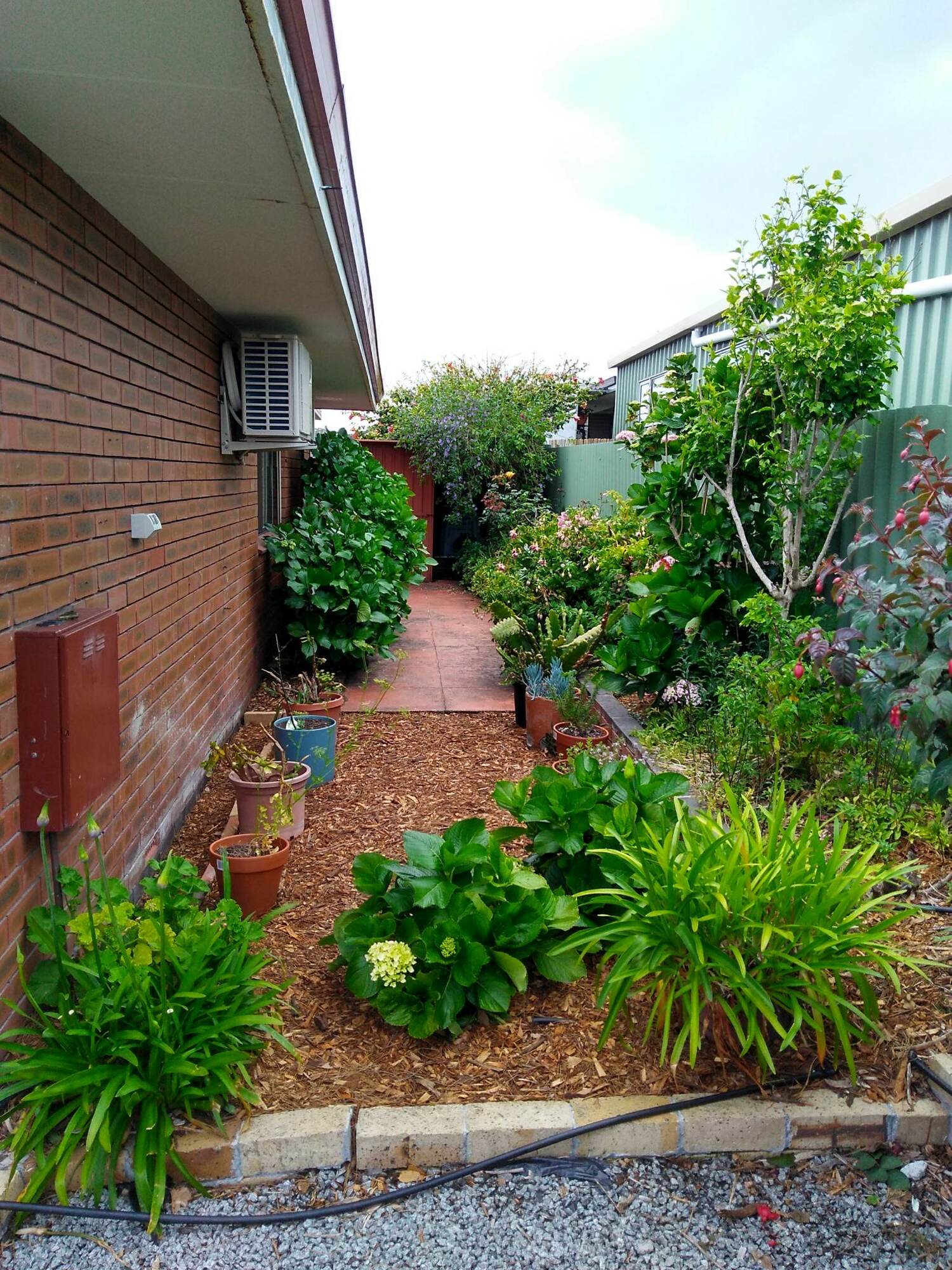
_(Not all asbestos outbuildings need to be replaced. This was the site of an ageing fibro shed. Its removal has enabled access to the rear of the dwelling and space for an air conditioning unit.) _
- Many old fibro houses have good bones that are often made out of jarrah, so sometimes there is the option of replacing the fibro cladding with something that is safe, sustainable and preferably much better insulated.
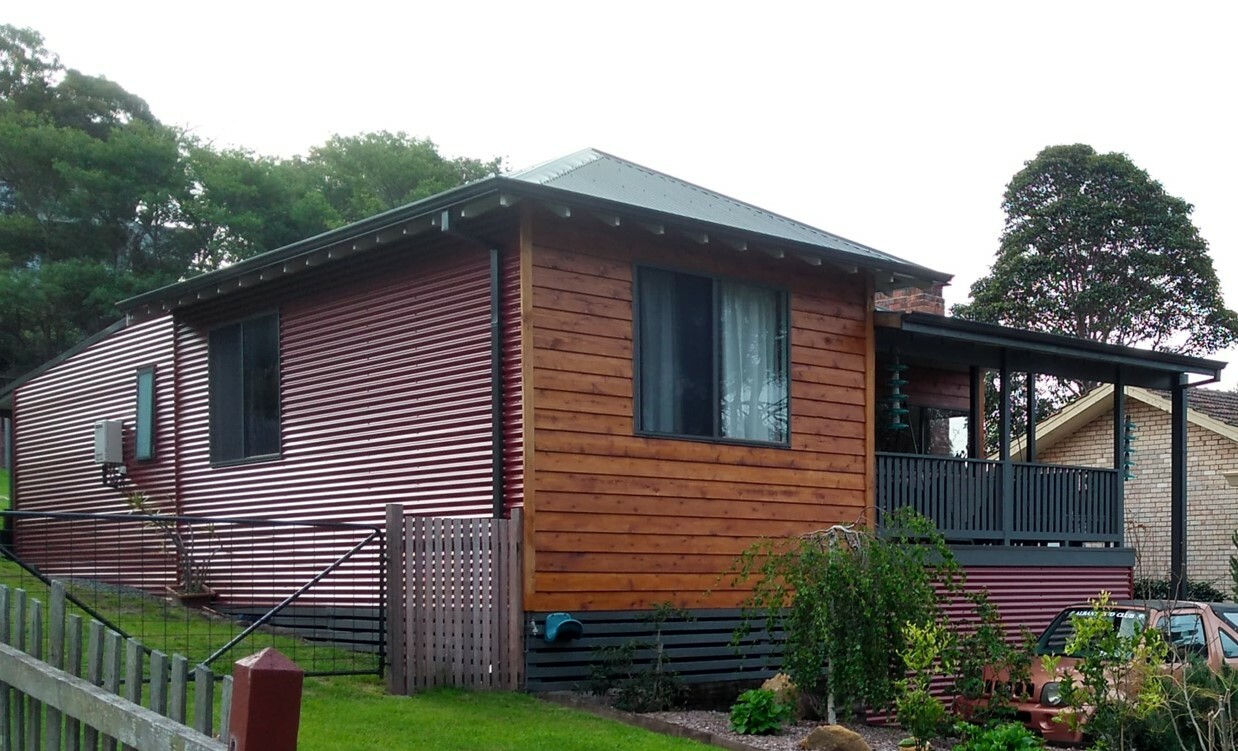
(Many fibro houses are built around robust frames often made out of jarrah and can be reclad)
We must prioritise the recycling and repurposing of building materials as much as possible in a post growth society. This will need to be coupled with stricter regulations to ensure that only quality new building products are used. Special care will need to be given to check that asbestos containing products are not being imported. The very last thing that we need to be doing is adding to the huge amount of asbestos that is already in Australia at a time when we are endeavouring to phase it out.
It is also crucial that we learn from our tragic past and the legacy that it has left us, by putting an end to activities that cause diseases such as silicosis. For example, our demand for imported manufactured stone must stop. Instead, we can pursue locally produced innovations such as kitchen worktops that are made out of recycled glass bottles, recycled concrete and good old-fashioned wood.
Thanks for reading!
Your PGAP co-hosts, Mark Allen and Michael Bayliss
]]>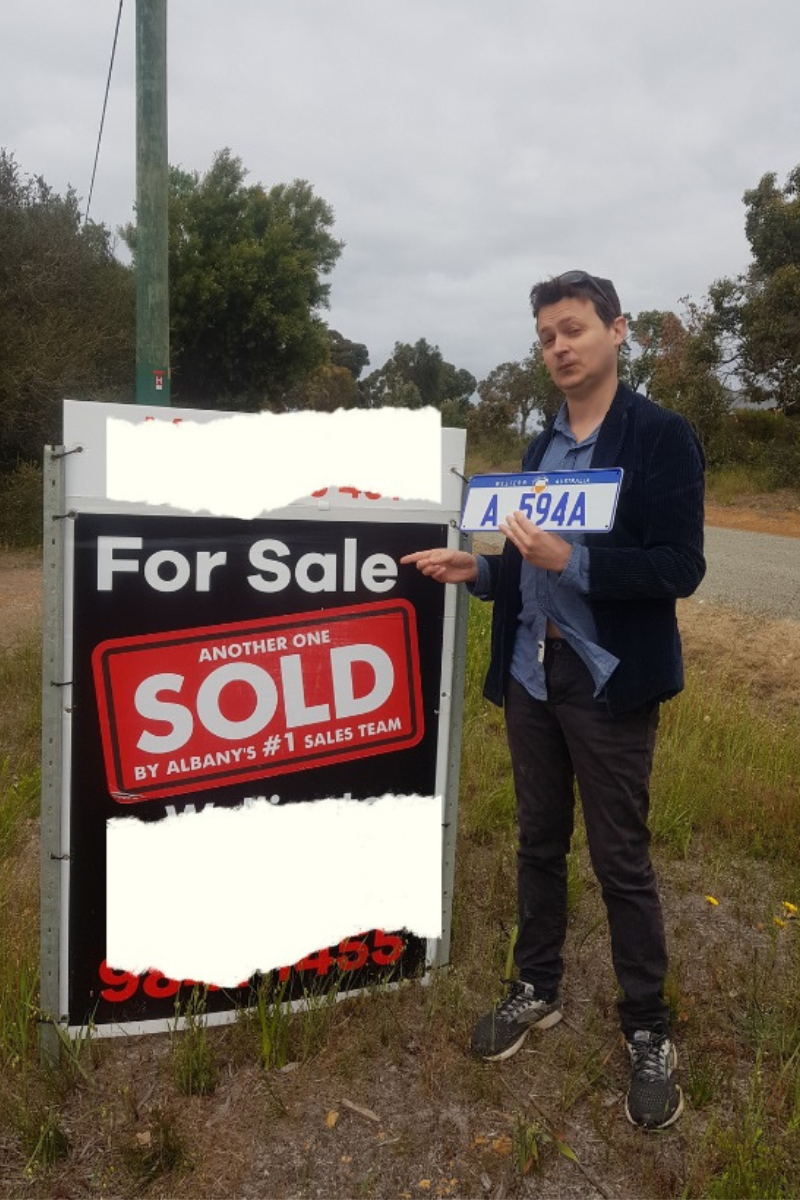
(This is the look of a man who no longer has to rent an asbestos shithole. Many Albany residents aren't so lucky. Much system change needed!)
Asbestos has a dramatic history in Western Australia. So much so that the town of Wittenoom is the site of one of the world’s worst industrial disasters where 2000 people have lost their lives to date. It remains to this day the largest contamination site in the southern hemisphere. This tragedy is covered in the famous Midnight Oil song ‘Blue Sky Mine.’ At least 4000 Australians continue to lose their lives every year from asbestos related diseases.
One would hope that our society might be together enough to learn from the tragedies of the past. In WA, our collective psyche seems to believe that asbestos was a disaster from another era and that we have moved on. Instead, we seem to be sweeping our past under the rug, out of sight out of mind. I mean this both figuratively and literally.
Several years ago, I was shocked to discover that, far from being a thing of the past, many new developments in our major cities are inadvertently being built with materials containing asbestos, often made in China and slipped under the radar of our deregulated building codes. The Perth children’s hospital development was an infamous example. Since moving to WA, asbestos has followed me around like a persistent ghost. At every point, my attempt to address this issue has encountered ineptitude, apathy and downright hostility from our broken and deteriorating social systems.
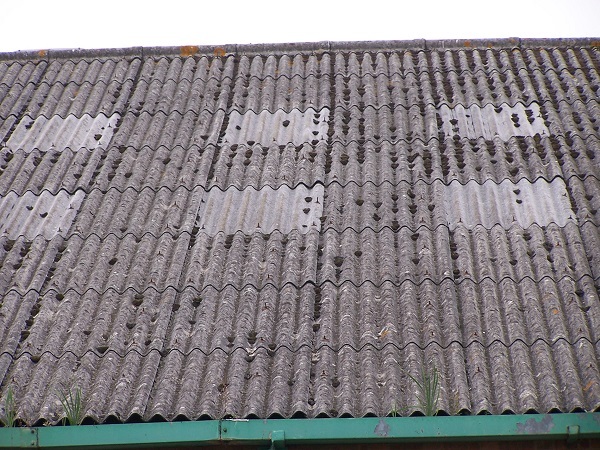
(What do you mean this aint pretty? WA was BUILT on this stuff. So what if it is an eyesore. Or a lungsore...photo courtesy of Shutterstock).
Below is an account of my past year dealing with asbestos in Albany, Western Australia. It is actually hilarious in a grim, Kafkaesque kind of way. Enjoy the ride!
It began in September 2021 when I moved quickly from Adelaide to Albany in a narrow gap between lockdowns and had to find a rental as quickly as possible. Bracing myself, I did a tour of the local real estate offices where they took great joy in telling me that "Albany is up-and-coming. That there is UNPRECEDENTED demand and little supply and that there may be a couple of places available BUT it won’t be easy and it won’t be cheap!" They love it, don’t they?
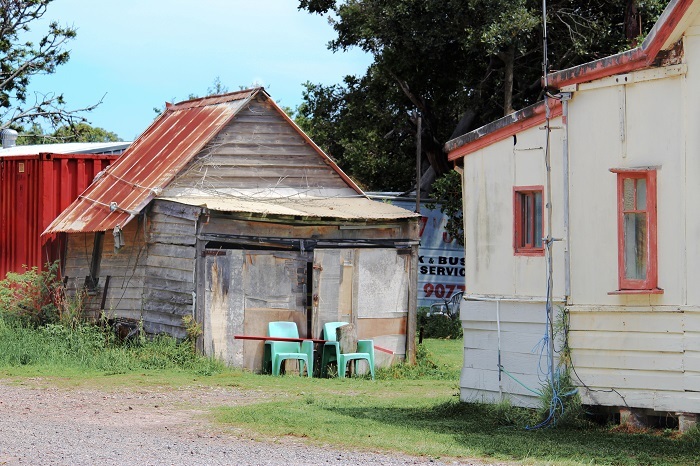
(You say dilapidation? I say INVESTMENT. There's a wait list for beauties like this in Albany. Photo courtesy of Shutterstock).
There happened to be a fibro box with a garden within walking distance from town going for $310 a week, which apparently was good value in this saturated market (consider the fact that the national housing market is so broken that even a regional town 5 hours south of the most isolated capital city in the world is still unaffordable). It obviously needed re-stumping as the bedroom wall was dropping and the floor was sloping so much in the front room there was a danger that I could roll out of bed. But it would have to do. So, I filled out a number of forms and in amongst it all there was a discrete, unassuming disclosure form which acknowledged that it was an asbestos structure. I knew that both the outside and inside asbestos walls were painted so I didn’t make much of it, so I moved in and dealt with all of the challenges of living in a house that had for the most part, been allowed to run itself down for many years.
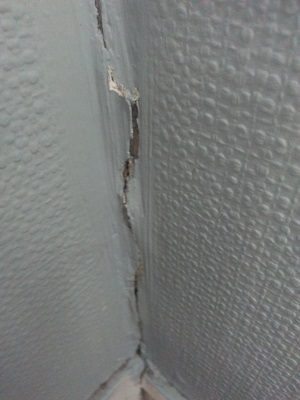
('Might need a restumping'. My rental was at such an angle that the walls were shearing apart. My property 'manager' was more interested in me keeping the grass cut. Priorities y'know.)
So, I was very happy when just before Christmas 2021, I was involved in the private purchase of a unit in Albany. This came as a huge relief as it finally enabled me to step away from Australia’s insidious rental industry. Finally, there was an opportunity to spend my hard-earned money in order to help build a place up, as opposed to parting with my money in order to finance a landlord’s mortgage (who in too many cases has little interest in maintaining it beyond the most basic levels of liveability).
Of course, bringing the unit - built in 1978- into the 21st Century, involved auditing the property for any asbestos that may have been used in its construction. _Asbestos was not phased out from housing construction in Australia until 1990. _
The first project was to remove an old asbestos shed that was attached to the side of the property. The second was to paint the decades old asbestos fences within close proximity to the property. It was too expensive in this instance to have the fences replaced, especially as it involved getting multiple neighbours involved. In order to audit a property, you need to know what you are looking for and it was while doing this research that I stumbled upon two little known facts. One is that old vinyl sheet flooring often has a backing that consists of 100 percent compressed asbestos fibres and that if disturbed, they can become instantly friable. At the same time, I discovered that asbestos was often added to the putty around windows.
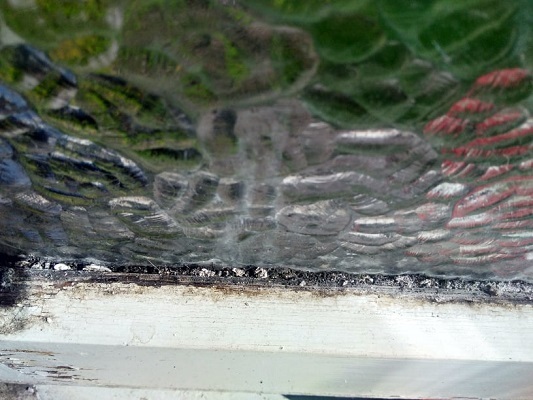
(like this one!)
What is friable asbestos I hear you ask? It is that which can be crumbled, pulverised or reduced to a powder by hand pressure. Much easier to get into air passages and wreak havoc, in other words.
While this wasn’t an issue in the house that I was involved in renovating, this research led me to discover (to my horror) that the house that I was renting, had an old ripped vinyl sheet floor with mysterious white powder oozing out of it in the bedroom. In addition, there was crumbling putty around the windows in multiple rooms that was leaving a fine greyish powder on the window ledges and floor. This sent alarm bells ringing, especially as I had been sweeping and vacuuming these powdery substances up for some months.
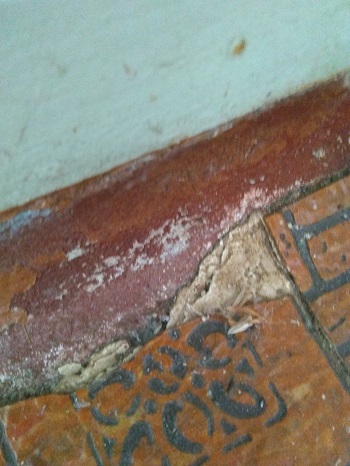
(Yes, the floor titles had seen better days).
Naturally my first reaction was to curse to high heaven. My second reaction was to take stock of circumstances. So, I wrote a fairly detailed email to the Property Manager outlining the issues and suggested that samples be taken from the vinyl in the front room as well as the crumbling putty in the windows. I stated that -
“If they both come out negative for asbestos, I will happily pay the remaining rent until the end of the lease and also pay to have the house cleaned. But obviously if you refuse to do the testing, I shouldn’t be expected to pay any more rent as it wouldn’t feel safe to return without a negative result.”
Up to this stage this issue had not been personal, it had been an obvious failure of the system, but the response from my property manager felt both brutal and personal. Not only was my request for testing ignored, she referred me to the asbestos disclosure that I had signed at the start of the lease. At the time of signing, I assumed that this disclosure was in reference to the landlord or agent not being liable if I (for example) drilled into the asbestos walls. I did not expect it to be used as an excuse to ignore the presence of potentially friable asbestos prior to the lease being signed. In other words, it could be used to override a landlord’s duty of care.
The property manager did agree to end the lease three weeks early but demanded that I continue to pay rent for the following two weeks without any testing being undertaken. So, I had to endure the double whammy of not knowing whether I had been exposed to asbestos while also being forced to pay a further 620 dollars in rent on a house that I no longer felt safe to live in.
So, I decided to seek legal advice. Surely, I thought, given the persisting legacy of asbestos in WA and given that this stuff, you know – kills, that the system would be perfectly geared to providing the advice that I needed quickly. How naïve was I? But seriously folks, there is where it gets ridiculous.
Tenancy WA referred me to a third-party legal advice organisation. In order to get someone to phone me, I had to fill out many forms, pay $40 and wait a whole week for the phone call, as they rescheduled and protracted. I was provided some very broad advice around needing to leave the house immediately (which by then I already had done), and some legal clauses that I could use as a tenant (which didn’t work in the end). The lawyer on the phone was not allowed to put anything into writing, which meant that I had to memorise a lot of complex legal jargon from a single phone call. Nor was I allowed to send through any draft correspondence that I was writing to the real estate agent in order to get advice on whether I was framing things correctly. Hence, it was a lot of busywork to get nowhere slowly, with the onus of responsibility thrust back onto yours truly.
I also contacted a community legal aid centre in Albany who would only accept my application AFTER I had had the discussion with Tenancy WA and after I summarised the conversation for them in writing. I also had to fill in a bunch of paperwork and documents for them. It then it took another month before I finally received one phone call from them. This was due to multiple factors, including the ONE tenancy lawyer being off sick with COVID, or unexpected emergencies in the office. Their automated appointment system was also inaccurate, giving me wrong dates and times, which meant that I had to call reception on many occasions to problem solve the issues with them. By the time they finally contacted me, it was well and truly after the fact.
In the meantime, I had vacated myself and my possessions out of the house. Because no testing had been done, I had no choice but to take the mattress that had been exposed to powder from the floor and the windows to the tip. I just couldn’t risk keeping it. Fortunately, I have an uncle with a holiday house in the Perth Hills which was vacant and where he said that I could stay for as long as necessary. Unfortunately, it was a five hour drive up the road. For all my displacement, I was thankful to have a stable job that allowed me to work from home (wherever home happened to be that month). It became apparent at that stage that I wouldn’t get any legal support any time soon so I begrudgingly paid the remaining two weeks rent, knowing that if I didn’t, I would lose my bond. But I couldn’t live with the uncertainty of whether or not I had been exposed to asbestos, so I ended up forking out to pay for the tests myself. So not only had I had to pay rent on a house that I did not feel safe living in, I also had to pay for the testing too.
Upon arriving at my uncles, I dared a deep sigh of relief that I was away from potential danger. Ironically as I drew in a nice big breath, I noticed bits of broken asbestos fencing scattered around his garden, some of which was mixed in with the gravel pathways where people regularly walk. So, I stopped breathing so freely as I embarked on a project to clean this up and have it taken away. I also noticed piles of it dumped in the adjoining bushland, which is something that I will have to tackle at a future date. This was in all likelihood a legacy from an asbestos house that was demolished on the site back in 1992. It seemed that there was no escaping from it.
In the meantime, I continued to call around for advice. Albany Council said that they ‘couldn’t intervene in real estate/tenancy relationships’ and my contact at Worksafe was reluctant to review a draft email that I had prepared in response to the real estate agent. The most absurd conversation was with the asbestos expert for a State health department. When I suggested to him that Real Estate organisations need to take a more proactive approach towards asbestos management, his response was ‘we live in a prosperous and affluent state and we can’t get in the way of business by forcing more legislation onto real estate agents.’ I couldn’t believe my ears.
There is a positive outcome to this story, at least for me. The asbestos results actually came back negative, much to the surprise of the asbestos professional who thought that at the very least, the vinyl floor sample would come back positive. On the same day he had tested another very similar vinyl floor in another house that turned out to be positive. It was the luck of the draw. He did say that I did the right thing by leaving the house immediately as it was the safe thing to do. Also, the real estate agent did return most of the bond in the end – although all of this amount and much more was consumed by the asbestos test fees, short term accommodation fees, the cost of relocation, driving to Perth, a new mattress and having to pay two weeks rent on an empty house.
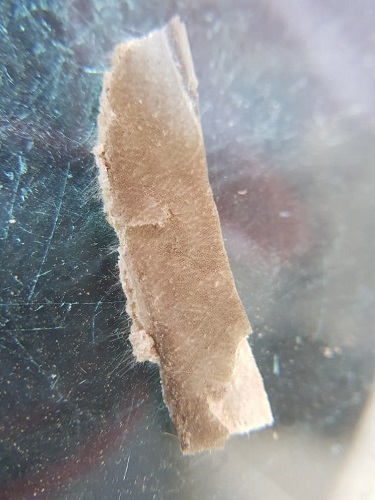
(The sample taken of the vinyl sheet flooring under the microscope showed to my relief that the white fibres were synthetic and not asbestos.)
I was so relieved with the outcome, if only for the fact that it took every ounce of my energy and capacity just to reach this point. Had results come back positive, the ensuing battle with the estate agent risked being long, protracted and nasty. I knew this because the asbestos professional who did the testing informed me that tenants have in the past spent years and in one case at least, tens of thousands of thousand dollars (as well as having to teach themselves law) in order to win cases against landlords.
Sadly, there is no solace to be found in the hope that the risk of exposure to asbestos in WA will recede any time soon. It is probable that Albany won’t even have the luxury of professionals who test for and remove asbestos in the medium-term future. Paying for someone to come down from Perth will be expensive, so many people won’t do it. Instead, they will take risks and cut corners. This is because the WA government is passing laws that make it even more costly to remove asbestos legally. When I had the small asbestos shed removed it cost two and a half thousand dollars. If I were doing that today it would likely cost three and half thousand.
Government agencies justify this because it is costing them a lot of money to remove illegally dumped asbestos in public areas. Of course people are in part illegally dumping asbestos because they don’t want to pay to do it properly. So, the state government have dim wittingly dug themselves into a positive feedback loop. This however is no excuse. The illegal dumping of asbestos is a serious offence and it should receive serious penalties. Nevertheless, we can only expect illegal asbestos dumping to get worse as costs become more prohibitive.
Of course, this is also indicative of a larger scale issue whereby too much power has been siphoned towards landlords and real estate companies, who get to write their own rules, are not held to account and are generally regarded as being too big to topple. I was lucky in the sense that I got to escape from the insidious rental ‘market’. Many others are not as fortunate as myself and are locked in for life. If the only place that becomes available is an asbestos shit hole, then it seems that you have to fork out the money and be “grateful”. If that means that you get mesothelioma or lung cancer or asbestosis, then it is clear that neither Albany’s largest real estate agent, nor the state government, care if you die.
If you still think that society is capable of learning from its past mistakes, I have one more shock for you. The dust from cutting manufactured stone, which is the standard for most kitchens in new homes, exposes workers to the risk of silicosis and this is a growing epidemic that is cutting the lives short of up to one in three people who work with manufactured stone. I have tried to promote a safe and ecological alternative to manufactured stone made out of recycled glass bottles to builders but this has fallen mostly on deaf ears. So, the cycle continues…
Ultimately, this article is not to incite despair and indifference, but rather to incite change. We need to make this into a political issue, especially as it feeds into a wide range of other issues around our dire housing situation. Too many have died. Too many more will die.
Given that both major parties have made careers out of sticking their heads in the sand, it is worth considering voting for a viable minor party. Don’t give (un)Real Estate Agents any more oxygen than is necessary for your survival. If you own your home or are renovating, please choose an alternative to stone kitchen bench tops. Also, If you get the opportunity to get asbestos professionally removed, please do, as you are doing the whole community a service. We want to phase out what is behind an enduring systemic industrial cancer inducing disaster.
As a footnote, I am currently building a house in outer Albany and have had to deal with exposed asbestos piping on-site on two occasions (and counting). This is a reminder that we have a long way to go before WA can truly put to rest the ghosts of Wittenoom.
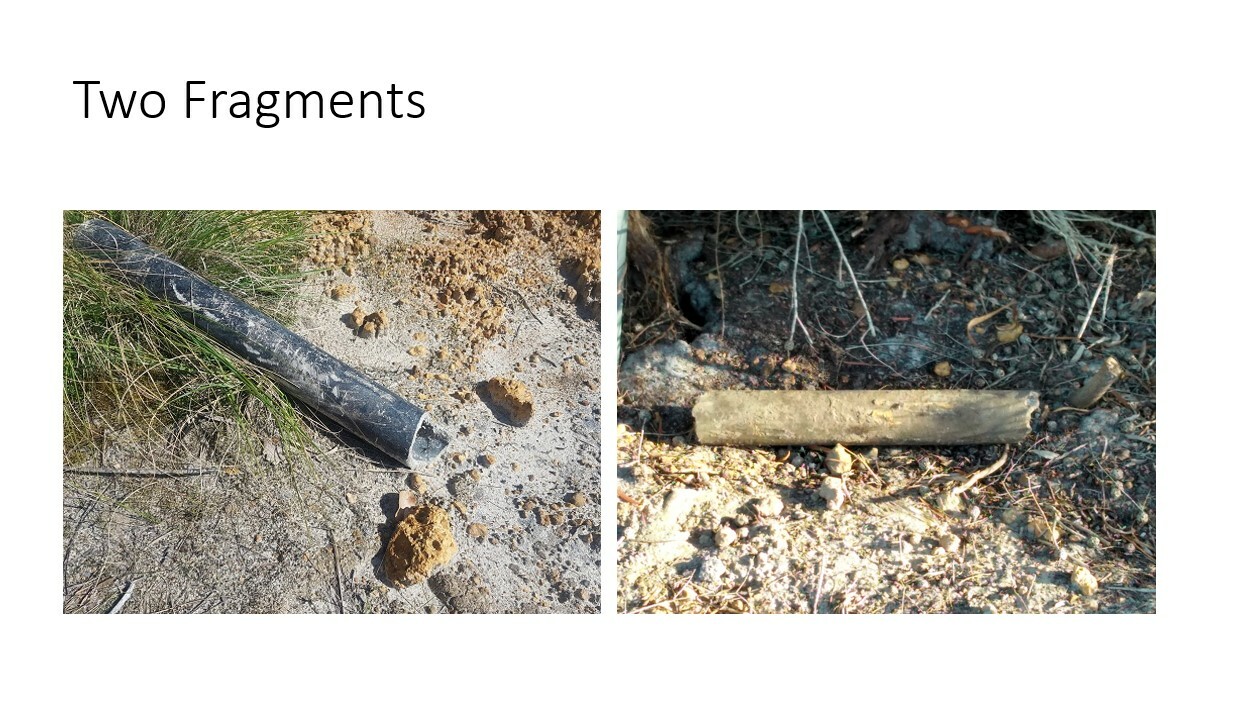
(Asbestos: the gift that keeps giving)
I will be co-writing a sequel to this article with Mark Allen from Town Planning Rebellion which will be looking at the policy directions that we should be taking in terms of handling our asbestos legacy as the rental crisis continues to bite. Also, how does this fit in with the wider approach that we need to be taking towards sustainable planning in WA?
]]>(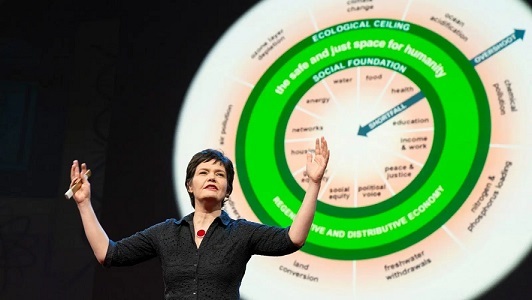 )
)
Link to the talk can be found here
]]>Meanwhile, populist right wing governments such as the Trump administration have declared war on family planning and sexual health services. Year by year, Australia's foreign aid budget dwindles
This simply cannot continue.
Please feel free to read the article in full here. If, like me, you just cannot bear to see this trend worsen, then consider giving generously to organisatins such as CHASE Africa, IPPF, Marie Stopes, WPF, UNFPA or Plan International.
]]>This September 15th, a unique social experiment aims to show that a more generous world is possible. On Free Money Day, now in its 10th year, people around the world hand out money, virtually or in person, asking recipients to pass half on to someone else.
Organized by the Post Growth Institute, the global event encourages conversations about the benefits of economies based on sharing. It offers an opportunity to inspire more critical and creative thinking about our relationships with money and how we can have new types of economic activity.
“Free Money Day is a chance to get money flowing more readily in our society and to inspire greater generosity, rather than shaming people into action. It’s a chance for people to experience how good it can feel to give, and a moving reminder that we’re all in this together,” said Donnie Maclurcan, Executive Director of the Post Growth Institute and Global Organizer of Free Money Day.
“It is time we asked ourselves again: how much is enough? Do we really need to grow on like this? This event is about much more than money, it is about co-creating the futures we truly desire by building on what we know works: sharing.
“Free Money Day is designed to help people connect with the complex issue of monetary circulation in a simple way, and inspire them to take action. It is a gateway to thinking about wider issues like the power of moving money to credit unions, the problems of for-profit banking, and the importance of debt forgiveness and universal basic income in creating a more fair world.“
With the Covid-19 situation varying across regions, people have three options to take part in Free Money Day 2020: 1) leave two banknotes as a surprise for someone in a public space, with a note asking the finder to pass one on, 2) share money in person by giving out two coins or notes at a time (while observing local health and safety measures), and 3) send money to someone via a digital payment platform.
Participants are encouraged to share their stories, photos, and videos online using the hashtag #freemoneyday, tag Free Money Day on Facebook, Instagram, and Twitter, and share their experiences with the media and the Free Money Day team.
Free Money Day is an annual, global event held since 2011 to promote sharing and alternative economic ideas. The day is held each year on September 15th, the anniversary of the Lehman Brothers’ 2008 filing for bankruptcy. Since its inception, 324 events have been organised in 218 locations in 35 countries.
The Post Growth Institute (PGI) is an international, not-for-profit organisation facilitating the shift to a world where people, companies, and nature thrive together within ecological limits. The world’s first group to integrate macro, micro, and community economy perspectives into a holistic vision for a sustainable future, the PGI strives to reimagine economics, from extractive accumulation to regenerative circulation; reorient organisations, from bloated, profit-maximisation to lean, purpose-driven approaches; and reconnect communities, from systemic isolation to strengths-based belonging.
For more information about Free Money Day 2020, visit freemoneyday.org
For more information about the Post Growth Institute, visit postgrowth.org
For media enquiries about Free Money Day 2020 or the Post Growth Institute, contact Natalie Holmes (+491601439827) and Donnie Maclurcan (+15416318680) on [email protected]
A media kit with images, logo, and a ‘How to Participate’ one-pager are available to download here. Quotes and further media info are available here.
]]>Shock Octopus have released a new EP 'Enter The Exit' that explores the themes of existentialism and environmental/climate grief.
The publication Scenstr recently interviewed Michael on his favourite 5 existential environmnetal themed songs.
Although it was tempting to include hoary chestnuts like 'Big Yellow Taxi' and 'Little Boxes' (both of which deal with overdevlopment and population - sort of), Michael dug some of the more obscure depths to include numbers from Lou Reed, Pixies, Bruce Cockburn, Martha Wainwright and Anohni
The full interview can be found here
]]>Whether you just want to browse the website, say hello, find out about the hubs, campaigns and webinars, and to become a MEMBER -
do visit NENA's website. They are doing many, many promosing things!
Find out more at their website here and be part of a brave new post-growth world.
]]>*
When I was living near Kisumu on the shores of Lake Victoria, I noticed such a difference between villages that had empowered women's cooperatives, accessible healthcare, and family planning services compared to the communities that did not. When these were not in place, people had only their local church groups to turn to. Unfortunately, in many cases, religion was not an adequate substitue, particularly in traditionally patriachal communities. Poverty, mental health issues, substance abuse and HIV were just some of the unfortunate outcomes.
This is why it is so crticial that organisations such as CHASE Africa exist. One can see, hear, feel the difference in the air when women have agency and control over their reproductive lives and the size of their families. The feeling is that of a weight being lifted in the air, a feeling of levity accross the whole community - it is really palpable!
Of all the charities out there, CHASE Africa is one of the most important (outside of Sustainable Population Australia - of course!) I'm going to be so bold as to put a link directly to their donation site here. Please visit - right now if possible, and consider donating generously. You really will make a difference.
Also, this (very) short video introduced me to the work of CHASE and I thoroughly recommend giving it a gander.
]]>"Counting Backwards was formed in Melbourne and Adelaide in 2018 to bring together like minded musicians to collaborate and raise awareness on the climate and ecological emergency. We are about rocking out to the revolution..."
About the song 'The End Of History':
"_A song about about impermanence, the repetition of history, being bogged down in the matrix and the need to dance.
_"
Come the post-growth revolution, we will still need music in our lives! So it is important to get in the habit of supporting local bands and artists - we won't have Spotify and stadium nostalgica concerts forever you know!
To find our more about Counting Backwards, click here
]]>They were also united on their challenges in discussing population sustainability in wider society, which still remains a controversial and misunderstood subject matter.
Here is a talking heads compilation of six of our favourite interviews
This video is part of SPA's Stop At 2 Campaign. We are encouraging a more open discussing around normalising choice around small or child free families. We are supporting a global movement that empowers people worldwide to be empowered and make informed decisions around family planning.
A link to the video can be found here
]]>In our - hopefully not too biased opinion - this is perhaps one of the most important petitions you could ever sign.
A link to the petition can be found here
In the words of CASSE itself:
The CASSE position sets the record straight on the conflict between economic growth and environmental protection. Climate change, biodiversity loss, and pollution are just three powerful examples. And how will the next generation find jobs when the planet can’t support our overgrown economy? The CASSE position calls for a desirable solution – a steady state economy with stabilized population and consumption – beginning in the wealthiest nations and not with extremist tactics. Join the likes of E. O. Wilson, Jane Goodall, and David Suzuki; fill in the information below to sign the position and support a healthy, sustainable economy.
]]>